Moira Butterfield's Blog, page 19
October 11, 2020
How to Become a Picture Book Idea Catcher by CHITRA SOUNDAR
Over the last few weeks, PBDenners have been talking about different topics that relate to the picture book world. From end papers to book launches, talking consent or children who are at a loss for words, there is a treasure trove of topics you can dip into.
This week I want go back to basics. Perhaps because I’m between projects and my mind is subconsciously searching for the next idea for a picture book.
I recently watched a clip in which Neil Gaiman answers an audience question about where you get your ideas from.
I loved his answer for so many reasons. First, this is a question everyone asks when they meet a writer – be it a school visit or at a cocktail party. Secondly, he thinks it through in real time, talking as he thinks and while the answer is never clear cut, he lays out a few fundamentals that are useful for all writers too. Go watch it.
With the pandemic raging across the world, and most of us stuck inside our homes, gathering ideas has become more of an indoor activity – at least for me.
So, when ideas flutter by, identify them, acknowledge them and file them for later. Ideas do grow and find other ideas to relate to. It’s like when you consciously look for red cars, all you can see on the road are red cars. When you see a glimmer of an idea, things that be compatible to that idea will attract your attention. You will notice things that you would have otherwise ignored.
But if you’re new to this idea-catching skill, you might need some help in the beginning until your own subconscious can take over.
Here are six tips to help you become a picture book idea-catcher.1. Read loads of picture books.This is totally obvious and yet most new writers I meet haven’t read that many books or haven’t books relating to the idea or type of story, they are working on. Read more contemporary picture books – perhaps published in the last 10 years or so.
2. Read baby development books.If you haven’t been near a baby / child/ toddler / pre-schooler in the last few years, chances are you need reminding on their behaviours. What can they do at which months / years and what they cannot do at certain ages. Not just physically, but emotionally and cognitively. Many of these books will tell you about the children’s fears, behaviours and about what they find interesting.
3. Look for words that children would love to say.Look for words that children might want to repeat. Or even phrases. Find funny sounding words. I’m not saying it will lead to a story directly. But it will definitely inspire ideas.
4. Write five What-if Statements every day.In your journal / writing notebook / laptop wherever you’re comfortable, imagine five age-appropriate what-if imaginings.
What if a turkey were to sing… and such…
This is a brainstorming activity and is very useful for exhausting what's on the shallow top layer of your brain and slowly dig into the ideas that lie beneath the surface.
Ever so often one of those sentences might spark a story – open a new document or turn a page and start writing.
5. Read fairy tales and folk tales.Firstly just for the joy of enduring stories. But secondly to see how some of those fairy tales might work out today. Or are there parallels in some stories to real life?
6. Read an encyclopaediaA visual one if you have it. But when you read it, read it like a child. What would a child find fascinating and now can you see a story in any of those fascinating topics?
Becoming an idea-catcher is a lifelong vocation. Start now and see how your little idea notebooks fill up. And every few months or so, go back and read your ideas notebook and see which ideas have found each other and will work great in the same story.
Good luck with your idea-catching!

Chitra Soundar is an internationally published, award-winning author of over 40 books for children. She is also an oral storyteller with a loud voice. She also writes trade fiction, non-fiction, poetry and theatre. Find out more at www.chitrasoundar.com. Follow her on twitter @csoundar
October 4, 2020
Express YourSHELF for National Libraries Week
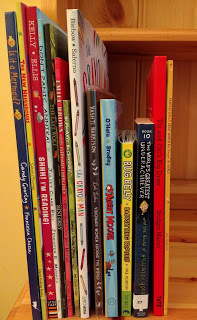

National Libraries Week kicks off today to celebrate the role of libraries in the UK’s book culture and promote libraries as “spaces for reading, engagement, learning and creativity.”
When did you last visit the library? Do you remember a school or class library from your childhood? If you have children, did you go to the bounce and rhyme times? Or maybe the library is a place where you go to work and think, meet people, or even learn a new skill. People come into the library for all kinds of reasons, including searching for elusive bits of information and archive materials.
“Libraries offer a safe space, providing access to digital & online learning, helping to combat loneliness and having a positive impact on people’s lives.” – Arts Council for England
Research shows that there is a correlation between getting families reading and children enjoying stories with them doing better at school and doing better in life. So, how can libraries engage children?
In “More than a House of Books", a Podcast commissioned by the Arts Council for England, Sarah Mears (Library Services Manager, Essex County Council. Former chair of the Association of Senior Children's and Education Librarians) stressed that the most important thing is the welcome they receive at the door.
The library needs to be “ . . . an exciting and vibrant space that attracts children. It's light, it's airy, it's colourful. There are lots of things that engage them. Activities for them to do, interesting technology that they may have not experienced in their own homes. But I think most importantly, it's still the books. Children love reading for pleasure and they love being inspired to read new titles, new authors.”
Today, libraries aren’t places of where librarians go ‘shhh!’; instead they are vibrant community hubs where authors, illustrators and storytellers visit, arts & crafts clubs meet, music and theatre activities inspire the imagination, and poetry groups perform.
Regrettably, many libraries are closing, but some – such as the new Manchester Library, which has soundproofed music area, and the Birmingham Library, with its roof gardens - are being imaginatively re-purposed and re-thought to inspire the next generation to “use the space to engage people both with reading and digital skills.” <!-- /* Font Definitions */ @font-face {font-family:"MS 明朝"; mso-font-charset:78; mso-generic-font-family:auto; mso-font-pitch:variable; mso-font-signature:-536870145 1791491579 18 0 131231 0;} @font-face {font-family:"Cambria Math"; panose-1:2 4 5 3 5 4 6 3 2 4; mso-font-charset:0; mso-generic-font-family:auto; mso-font-pitch:variable; mso-font-signature:-536870145 1107305727 0 0 415 0;} @font-face {font-family:"Trebuchet MS"; panose-1:2 11 6 3 2 2 2 2 2 4; mso-font-charset:0; mso-generic-font-family:auto; mso-font-pitch:variable; mso-font-signature:647 0 0 0 159 0;} /* Style Definitions */ p.MsoNormal, li.MsoNormal, div.MsoNormal {mso-style-unhide:no; mso-style-qformat:yes; mso-style-parent:""; margin:0cm; margin-bottom:.0001pt; mso-pagination:widow-orphan; font-size:12.0pt; font-family:"Times New Roman"; mso-fareast-font-family:"MS 明朝"; mso-fareast-theme-font:minor-fareast; mso-ansi-language:EN-US;} .MsoChpDefault {mso-style-type:export-only; mso-default-props:yes; font-size:10.0pt; mso-ansi-font-size:10.0pt; mso-bidi-font-size:10.0pt; mso-fareast-font-family:"MS 明朝"; mso-fareast-theme-font:minor-fareast; mso-fareast-language:JA;}size:612.0pt 792.0pt; margin:72.0pt 90.0pt 72.0pt 90.0pt; mso-header-margin:36.0pt; mso-footer-margin:36.0pt; mso-paper-source:0;} div.WordSection1 {page:WordSection1;}</style><span lang="EN-US" style="font-family: "Trebuchet MS"; font-size: 12.0pt; mso-ansi-language: EN-US; mso-bidi-font-family: "Times New Roman"; mso-bidi-language: AR-SA; mso-fareast-font-family: "MS 明朝"; mso-fareast-language: EN-US; mso-fareast-theme-font: minor-fareast;"></span> <p class="MsoNormal"><span style="font-family: trebuchet;"><i><span style="font-size: 13.5pt; mso-ansi-language: EN-GB; mso-fareast-font-family: "Times New Roman";"><style><!-- /* Font Definitions */ @font-face {font-family:"MS 明朝"; mso-font-charset:78; mso-generic-font-family:auto; mso-font-pitch:variable; mso-font-signature:-536870145 1791491579 18 0 131231 0;} @font-face {font-family:"Cambria Math"; panose-1:2 4 5 3 5 4 6 3 2 4; mso-font-charset:0; mso-generic-font-family:auto; mso-font-pitch:variable; mso-font-signature:-536870145 1107305727 0 0 415 0;} @font-face {font-family:Georgia; panose-1:2 4 5 2 5 4 5 2 3 3; mso-font-alt:Georgia; mso-font-charset:0; mso-generic-font-family:auto; mso-font-pitch:variable; mso-font-signature:647 0 0 0 159 0;} @font-face {font-family:"Trebuchet MS"; panose-1:2 11 6 3 2 2 2 2 2 4; mso-font-charset:0; mso-generic-font-family:auto; mso-font-pitch:variable; mso-font-signature:647 0 0 0 159 0;} /* Style Definitions */ p.MsoNormal, li.MsoNormal, div.MsoNormal {mso-style-unhide:no; mso-style-qformat:yes; mso-style-parent:""; margin:0cm; margin-bottom:.0001pt; mso-pagination:widow-orphan; font-size:12.0pt; font-family:"Times New Roman"; mso-fareast-font-family:"MS 明朝"; mso-fareast-theme-font:minor-fareast; mso-ansi-language:EN-US;} a:link, span.MsoHyperlink {mso-style-priority:99; color:blue; text-decoration:underline; text-underline:single;} a:visited, span.MsoHyperlinkFollowed {mso-style-noshow:yes; mso-style-priority:99; color:purple; mso-themecolor:followedhyperlink; text-decoration:underline; text-underline:single;} p.Default, li.Default, div.Default {mso-style-name:Default; mso-style-unhide:no; mso-style-parent:""; margin:0cm; margin-bottom:.0001pt; mso-pagination:none; mso-layout-grid-align:none; text-autospace:none; font-size:12.0pt; font-family:Georgia; mso-fareast-font-family:"MS 明朝"; mso-fareast-theme-font:minor-fareast; mso-bidi-font-family:Georgia; color:black; mso-ansi-language:EN-US; mso-fareast-language:JA;} .MsoChpDefault {mso-style-type:export-only; mso-default-props:yes; font-size:10.0pt; mso-ansi-font-size:10.0pt; mso-bidi-font-size:10.0pt; mso-fareast-font-family:"MS 明朝"; mso-fareast-theme-font:minor-fareast; mso-fareast-language:JA;}size:612.0pt 792.0pt; margin:72.0pt 90.0pt 72.0pt 90.0pt; mso-header-margin:36.0pt; mso-footer-margin:36.0pt; mso-paper-source:0;} div.WordSection1 {page:WordSection1;}</style> </span></i></span><span style="mso-ansi-language: EN-GB; mso-fareast-font-family: "Times New Roman";"></span></p> <p class="MsoNormal"><span lang="EN-US" style="font-family: "Trebuchet MS"; mso-fareast-font-family: "Times New Roman";"><style><!-- /* Font Definitions */ @font-face {font-family:"MS 明朝"; mso-font-charset:78; mso-generic-font-family:auto; mso-font-pitch:variable; mso-font-signature:-536870145 1791491579 18 0 131231 0;} @font-face {font-family:"Cambria Math"; panose-1:2 4 5 3 5 4 6 3 2 4; mso-font-charset:0; mso-generic-font-family:auto; mso-font-pitch:variable; mso-font-signature:-536870145 1107305727 0 0 415 0;} /* Style Definitions */ p.MsoNormal, li.MsoNormal, div.MsoNormal {mso-style-unhide:no; mso-style-qformat:yes; mso-style-parent:""; margin:0cm; margin-bottom:.0001pt; mso-pagination:widow-orphan; font-size:12.0pt; font-family:"Times New Roman"; mso-fareast-font-family:"MS 明朝"; mso-fareast-theme-font:minor-fareast; mso-ansi-language:EN-US;} .MsoChpDefault {mso-style-type:export-only; mso-default-props:yes; font-size:10.0pt; mso-ansi-font-size:10.0pt; mso-bidi-font-size:10.0pt; mso-fareast-font-family:"MS 明朝"; mso-fareast-theme-font:minor-fareast; mso-fareast-language:JA;}size:612.0pt 792.0pt; margin:72.0pt 90.0pt 72.0pt 90.0pt; mso-header-margin:36.0pt; mso-footer-margin:36.0pt; mso-paper-source:0;} div.WordSection1 {page:WordSection1;}</style></span></p><p></p><span style="font-size: small;"><span style="font-family: trebuchet;"> </span></span><p class="MsoNormal"><span lang="EN-US" style="font-family: "Trebuchet MS"; mso-fareast-font-family: "Times New Roman";"><style><font size="3"><span style="font-family: trebuchet;"><!-- /* Font Definitions */ @font-face {font-family:"MS 明朝"; mso-font-charset:78; mso-generic-font-family:auto; mso-font-pitch:variable; mso-font-signature:-536870145 1791491579 18 0 131231 0;} @font-face {font-family:"Cambria Math"; panose-1:2 4 5 3 5 4 6 3 2 4; mso-font-charset:0; mso-generic-font-family:auto; mso-font-pitch:variable; mso-font-signature:-536870145 1107305727 0 0 415 0;} /* Style Definitions */ p.MsoNormal, li.MsoNormal, div.MsoNormal {mso-style-unhide:no; mso-style-qformat:yes; mso-style-parent:""; margin:0cm; margin-bottom:.0001pt; mso-pagination:widow-orphan; font-size:12.0pt; font-family:"Times New Roman"; mso-fareast-font-family:"MS 明朝"; mso-fareast-theme-font:minor-fareast; mso-ansi-language:EN-US;} .MsoChpDefault {mso-style-type:export-only; mso-default-props:yes; font-size:10.0pt; mso-ansi-font-size:10.0pt; mso-bidi-font-size:10.0pt; mso-fareast-font-family:"MS 明朝"; mso-fareast-theme-font:minor-fareast; mso-fareast-language:JA;}size:612.0pt 792.0pt; margin:72.0pt 90.0pt 72.0pt 90.0pt; mso-header-margin:36.0pt; mso-footer-margin:36.0pt; mso-paper-source:0;} div.WordSection1 {page:WordSection1;</span></font></style></span></p><p class="MsoNormal"><span lang="EN-US" style="font-family: "Trebuchet MS"; mso-fareast-font-family: "Times New Roman";">Libraries are filled with wonderful new contemporary books to explore, and dedicated, knowledgeable librarians who are thrilled to help you. You can check out a whole pile of books to explore new ideas, discover and re-read favourite authors & illustrators, and even learn new skills. If something doesn’t resonate, I love that <span style="background-color: #01ffff;">the books come with no strings attached – you can simply return them and check out some more – for free! </span></span> </p><p class="MsoNormal"><span lang="EN-US" style="font-family: "Trebuchet MS"; mso-fareast-font-family: "Times New Roman";"> </span></p><div class="separator" style="clear: both; text-align: center;"><a href="https://1.bp.blogspot.com/-boS5qX3Edj..." style="margin-left: 1em; margin-right: 1em;"><img border="0" data-original-height="172" data-original-width="730" height="94" src="https://1.bp.blogspot.com/-boS5qX3Edj..." width="400" /></a></div><br /><p></p> <p class="MsoNormal"><span lang="EN-US" style="font-family: "Trebuchet MS"; mso-fareast-font-family: "Times New Roman";">As part of the campaign for National Libraries Week, six <a href="http://www.britishisles.scbwi.org" target="_blank">SCBWI</a>authors were invited to participate in CILIP’s Express YourSHELF campaign and make a video about the books that influenced us. </span></p> <p class="MsoNormal"><span lang="EN-US" style="font-family: "Trebuchet MS"; mso-fareast-font-family: "Times New Roman";"> </span></p> <p class="MsoNormal"><span lang="EN-US" style="font-family: "Trebuchet MS"; mso-fareast-font-family: "Times New Roman";">For me, books are like friends, so choosing favourites was tricky! <span style="mso-spacerun: yes;"> </span></span></p> <p class="MsoNormal"><span face=""Open Sans","sans-serif"" lang="EN-US" style="color: #3f3e3e; font-size: 11.5pt; mso-bidi-font-family: "Open Sans"; mso-fareast-font-family: "Times New Roman"; mso-fareast-language: EN-GB;"> </span></p> <p class="MsoNormal"><b><span lang="EN-US" style="font-family: "Trebuchet MS"; mso-fareast-font-family: "Times New Roman";">You can see the videos <a href="http://picturebookden.blogspot.com/20..." target="_blank">here</a> at midday each day this week. </span></b></p> <p class="MsoNormal"><span lang="EN-US" style="font-family: "Trebuchet MS"; mso-fareast-font-family: "Times New Roman";"> </span></p> <p class="MsoNormal"><span lang="EN-US" style="font-family: "Trebuchet MS"; mso-fareast-font-family: "Times New Roman";">And <span style="background-color: #fcff01;">YOU can join in too!<span style="background-color: white;"> </span></span>Express yourSHELF by s</span><span lang="EN-US" style="color: #3f3e3e; font-family: "Trebuchet MS"; mso-bidi-font-family: "Open Sans"; mso-fareast-font-family: "Times New Roman"; mso-fareast-language: EN-GB;">haring some books that shaped YOUR world by snapping a pic of your book shelves, too, and posting on social media with hashtag </span><b><span lang="EN-US" style="font-family: "Trebuchet MS";">#ExpressYourshelf</span></b><span lang="EN-US" style="color: #3f3e3e; font-family: "Trebuchet MS"; mso-bidi-font-family: "Open Sans"; mso-fareast-font-family: "Times New Roman"; mso-fareast-language: EN-GB;"></span></p> <p class="MsoNormal"><span lang="EN-US" style="font-family: "Trebuchet MS"; mso-fareast-font-family: "Times New Roman";"> </span></p> <p class="MsoNormal"><span lang="EN-US" style="font-family: "Trebuchet MS"; mso-fareast-font-family: "Times New Roman";">The thing about libraries is they are there for all stages of your life and for the whole family:</span></p><p class="MsoNormal"><span lang="EN-US" style="font-family: "Trebuchet MS"; mso-fareast-font-family: "Times New Roman";"> </span></p><p class="MsoNormal"><span lang="EN-US" style="font-family: "Trebuchet MS"; mso-fareast-font-family: "Times New Roman";">In lower school, I went to the library at break time to hang out with the books and magazines, and choose new ones; I even made library cards for the small shelf of books I owned at home (mostly birthday presents sent by my grandmother who lived in England).</span></p> <p class="MsoNormal"><span lang="EN-US" style="font-family: "Trebuchet MS"; mso-fareast-font-family: "Times New Roman";"> </span></p><table align="center" cellpadding="0" cellspacing="0" class="tr-caption-container" style="margin-left: auto; margin-right: auto;"><tbody><tr><td style="text-align: center;"><a href="https://1.bp.blogspot.com/-anUY8jbc96..." style="margin-left: auto; margin-right: auto;"><img border="0" data-original-height="654" data-original-width="963" height="271" src="https://1.bp.blogspot.com/-anUY8jbc96..." width="400" /></a></td></tr><tr><td class="tr-caption" style="text-align: center;"><span style="font-size: x-small;">The EARJ lower school library had a lovely central area <br />where we could read beneath the colourful papier maché elephant</span><br /></td></tr></tbody></table><span lang="EN-US" style="font-family: "Trebuchet MS"; mso-fareast-font-family: "Times New Roman";"><br /></span><p></p> <p class="MsoNormal"><span lang="EN-US" style="font-family: "Trebuchet MS"; mso-fareast-font-family: "Times New Roman";">In high school, I spent most of my lunch times in the library eating my sandwich on the sly while hanging out with my friends (we weren’t allowed to eat in the library). In those days, you went to the library after school and in class to look stuff up in the Encyclopedias; reference books couldn’t leave the reading room because they had to be on hand for all students to use for research. Strange, now we can ask Google everything!</span></p> <p class="MsoNormal"><span lang="EN-US" style="font-family: "Trebuchet MS"; mso-fareast-font-family: "Times New Roman";"> </span></p> <p class="MsoNormal"><span lang="EN-US" style="font-family: "Trebuchet MS"; mso-fareast-font-family: "Times New Roman";">Now, I go to my local library almost every week to get a pile of bedtime reading, to see what’s new in picture books and check out nonfiction kids’ books for research. </span></p><p class="MsoNormal"><span lang="EN-US" style="font-family: "Trebuchet MS"; mso-fareast-font-family: "Times New Roman";"><br /></span></p><p class="MsoNormal"><span lang="EN-US" style="font-family: "Trebuchet MS"; mso-fareast-font-family: "Times New Roman";"></span></p><table align="center" cellpadding="0" cellspacing="0" class="tr-caption-container" style="margin-left: auto; margin-right: auto;"><tbody><tr><td style="text-align: center;"><a href="https://1.bp.blogspot.com/-l6MuJok8Dj..." style="margin-left: auto; margin-right: auto;"><img border="0" data-original-height="2048" data-original-width="1603" height="400" src="https://1.bp.blogspot.com/-l6MuJok8Dj..." width="313" /> </a></td><td style="text-align: center;"> </td></tr><tr><td class="tr-caption" style="text-align: center;"><span style="font-size: x-small;">A pile of TRUE story picture books to pore over</span><br /></td></tr></tbody></table><span lang="EN-US" style="font-family: "Trebuchet MS"; mso-fareast-font-family: "Times New Roman";"><br /></span><p></p> <p class="MsoNormal"><span lang="EN-US" style="font-family: "Trebuchet MS"; mso-fareast-font-family: "Times New Roman";"><span lang="EN-US" style="font-family: "Trebuchet MS"; mso-fareast-font-family: "Times New Roman";">There is something comforting about being amongst all those book friends, the promise of a story or a new idea or a-ha moment. <b>You never know – until you get home and crack open the covers – whether it’s the right book for you, but it’s ever so exciting!</b></span></span></p><p class="MsoNormal"><span lang="EN-US" style="font-family: "Trebuchet MS"; mso-fareast-font-family: "Times New Roman";"> </span></p><p class="MsoNormal"><span style="background-color: #01ffff;"><span lang="EN-US" style="font-family: "Trebuchet MS"; mso-fareast-font-family: "Times New Roman";">I asked some fellow Picture Book Den authors to share some stories of how libraries have influenced their lives, too:</span></span></p> <p class="MsoNormal"><span style="font-family: "Trebuchet MS"; mso-ansi-language: EN-GB; mso-fareast-font-family: "Times New Roman";"> </span></p> <p class="MsoNormal"><b><span style="color: black; font-family: "Trebuchet MS"; mso-ansi-language: EN-GB; mso-fareast-font-family: "Times New Roman";">Lucy Rowland</span></b></p> <p class="MsoNormal"><span style="color: black; font-family: "Trebuchet MS"; mso-ansi-language: EN-GB; mso-fareast-font-family: "Times New Roman";"> <br /></span></p> <p class="MsoNormal"><span lang="EN-US" style="font-family: "Trebuchet MS"; mso-fareast-font-family: "Times New Roman";"><span> </span>“I remember my primary school library the best – <b style="mso-bidi-font-weight: normal;">a calm quiet space</b>where we would be taken in small groups to borrow beautiful books. It was also used as a spill-over learning area so we had some of our most exciting lessons in there - music lessons, a craft workshop, a puppet show performance. For that reason, <b style="mso-bidi-font-weight: normal;">the library always felt like a rather special place</b>!” </span></p> <p class="MsoNormal"><span lang="EN-US" style="font-family: "Trebuchet MS"; mso-fareast-font-family: "Times New Roman";"> </span></p> <p class="MsoNormal"><b><span style="color: black; font-family: "Trebuchet MS"; mso-ansi-language: EN-GB; mso-fareast-font-family: "Times New Roman";">Jane Clarke</span></b></p><b> </b><p class="MsoNormal"><b><span style="color: black; font-family: "Trebuchet MS"; mso-ansi-language: EN-GB; mso-fareast-font-family: "Times New Roman";"> </span></b></p> <p class="MsoNormal"><span lang="EN-US" style="color: #333333; font-family: "Trebuchet MS"; mso-fareast-font-family: "Times New Roman";"><span> </span>“As I child, I loved Kettering's town library. I'd rush up the steps, dash into the children's section, <b style="mso-bidi-font-weight: normal;">scoop up armfuls of books, then retire to a quiet corner to sit on the floor and decide which to take home</b>. When I discovered new series, there were nerve-racking moments - would the title I had set my heart on be on the shelf - or had it already been borrowed? Oh, the joy if it was there!”</span></p><p class="MsoNormal"><span lang="EN-US" style="color: #333333; font-family: "Trebuchet MS"; mso-fareast-font-family: "Times New Roman";"> </span></p><p class="MsoNormal"><span lang="EN-US" style="color: #333333; font-family: "Trebuchet MS"; mso-fareast-font-family: "Times New Roman";"></span></p><table align="center" cellpadding="0" cellspacing="0" class="tr-caption-container" style="margin-left: auto; margin-right: auto;"><tbody><tr><td style="text-align: center;"><a href="https://1.bp.blogspot.com/-tWkVOq4MCY..." style="margin-left: auto; margin-right: auto;"><img border="0" data-original-height="1232" data-original-width="1792" height="275" src="https://1.bp.blogspot.com/-tWkVOq4MCY..." width="400" /></a></td></tr><tr><td class="tr-caption" style="text-align: center;"><span style="font-size: x-small;">Jane Clarke entertains her library audience with a science activity </span><br /></td></tr></tbody></table><span lang="EN-US" style="color: #333333; font-family: "Trebuchet MS"; mso-fareast-font-family: "Times New Roman";"><br /></span><p></p> <p class="MsoNormal"><b><span style="color: black; font-family: "Trebuchet MS"; mso-ansi-language: EN-GB; mso-fareast-font-family: "Times New Roman";">Clare Helen Welsh</span></b></p><p class="MsoNormal"><span style="color: black; font-family: "Trebuchet MS"; mso-ansi-language: EN-GB; mso-fareast-font-family: "Times New Roman";"> </span></p> <table align="center" cellpadding="0" cellspacing="0" class="tr-caption-container" style="margin-left: auto; margin-right: auto;"><tbody><tr><td style="text-align: center;"><a href="https://1.bp.blogspot.com/-gWQE8PnBYh..." style="margin-left: auto; margin-right: auto;"><img border="0" data-original-height="551" data-original-width="750" height="294" src="https://1.bp.blogspot.com/-gWQE8PnBYh..." width="400" /></a></td></tr><tr><td class="tr-caption" style="text-align: center;"><span style="font-size: x-small;">Clare Helen Welsh enthralls her young audience</span><br /></td></tr></tbody></table><p class="MsoNormal"><span style="color: black; font-family: "Trebuchet MS"; mso-ansi-language: EN-GB; mso-fareast-font-family: "Times New Roman";"> </span><span style="color: black; font-family: "Trebuchet MS"; mso-ansi-language: EN-GB; mso-bidi-font-style: italic; mso-fareast-font-family: "Times New Roman";"></span></p> <p class="MsoNormal"><span style="color: black; font-family: "Trebuchet MS"; mso-ansi-language: EN-GB; mso-bidi-font-style: italic; mso-fareast-font-family: "Times New Roman";"><span> </span>“I don't actually remember visiting the library as a child, which is a huge shame. I'm sure we did and that it's just my foggy memory, but I vividly remember taking my classes to the library as part of my job as primary school teacher. The informal visits provided the <b style="mso-bidi-font-weight: normal;">opportunity to pore over worlds and characters, words and pictures</b>. The times we went to meet <b style="mso-bidi-font-weight: normal;">visiting authors, illustrators and storytellers</b> were just as memorable. I'm certain they inspired the children and they definitely inspired me. I now have the outrageous privilege of writing stories that live on those shelves, and delivering story sessions just like the ones I watched<b style="mso-bidi-font-weight: normal;">. </b></span></p><p class="MsoNormal"><span style="color: black; font-family: "Trebuchet MS"; mso-ansi-language: EN-GB; mso-bidi-font-style: italic; mso-fareast-font-family: "Times New Roman";"><b style="mso-bidi-font-weight: normal;"> </b></span></p><p class="MsoNormal"><span style="color: black; font-family: "Trebuchet MS"; mso-ansi-language: EN-GB; mso-bidi-font-style: italic; mso-fareast-font-family: "Times New Roman";"><b style="mso-bidi-font-weight: normal;"></b></span></p><table align="center" cellpadding="0" cellspacing="0" class="tr-caption-container" style="margin-left: auto; margin-right: auto;"><tbody><tr><td style="text-align: center;"><a href="https://1.bp.blogspot.com/-K4am0p-CTJ..." style="margin-left: auto; margin-right: auto;"><img border="0" data-original-height="1750" data-original-width="2048" height="341" src="https://1.bp.blogspot.com/-K4am0p-CTJ..." width="400" /></a></td></tr><tr><td class="tr-caption" style="text-align: center;"><span style="font-size: x-small;">Craft activities with author Clare Helen Welsh</span><br /></td></tr></tbody></table><span style="color: black; font-family: "Trebuchet MS"; mso-ansi-language: EN-GB; mso-bidi-font-style: italic; mso-fareast-font-family: "Times New Roman";"><b style="mso-bidi-font-weight: normal;"><br /></b></span><p></p><p class="MsoNormal"><span style="color: black; font-family: "Trebuchet MS"; mso-ansi-language: EN-GB; mso-bidi-font-style: italic; mso-fareast-font-family: "Times New Roman";"><b style="mso-bidi-font-weight: normal;">I wonder if I would have had the courage to make the step from teacher to writer, had it not been for the possibilities the library gave me.</b> Of course, in these increasingly challenging times the battle is keeping libraries open and keeping them alive. But we must - a library is so much more than library.”</span></p><p class="MsoNormal"><span style="color: black; font-family: "Trebuchet MS"; mso-ansi-language: EN-GB; mso-bidi-font-style: italic; mso-fareast-font-family: "Times New Roman";"><br /> </span><span style="color: black; font-family: "Trebuchet MS"; mso-ansi-language: EN-GB; mso-fareast-font-family: "Times New Roman";"></span></p><p class="MsoNormal"><b><span style="font-family: "Trebuchet MS"; mso-ansi-language: EN-GB; mso-fareast-font-family: "Times New Roman";">Pippa Goodhart</span></b></p><p><span style="font-family: "Trebuchet MS"; mso-ansi-language: EN-GB; mso-fareast-font-family: "Times New Roman";"><span style="mso-tab-count: 1;"><span> </span> </span>“When my children were little, <b style="mso-bidi-font-weight: normal;">a visit to the library was the treat at the end of the weekly shop. </b>I think a lot of people find the huge number of books on shelves in libraries daunting, and don’t know where to begin with choosing<b style="mso-bidi-font-weight: normal;">. Children just find the right shelves and get stuck in! But we do need expert librarians unhand to help pair the right child with the right book at the right time,</b> especially with those books that might comfort or inspire or enlighten at particular moments in a child’s life. Or an adult’s life, come to that!</span></p><p class="MsoNormal"><span style="font-family: "Trebuchet MS"; mso-ansi-language: EN-GB; mso-fareast-font-family: "Times New Roman";"><br /></span></p><table align="center" cellpadding="0" cellspacing="0" class="tr-caption-container" style="margin-left: auto; margin-right: auto;"><tbody><tr><td style="text-align: center;"><span style="font-size: x-small;"><img border="0" data-original-height="2048" data-original-width="1536" height="320" src="https://1.bp.blogspot.com/-Ur3ugrlTTW..." style="margin-left: auto; margin-right: auto;" /></span><a href="https://1.bp.blogspot.com/-cokxyJJjVh..." style="margin-left: auto; margin-right: auto;"><img border="0" data-original-height="1024" data-original-width="768" height="320" src="https://1.bp.blogspot.com/-cokxyJJjVh..." /></a></td></tr><tr><td class="tr-caption" style="text-align: center;"> <p class="MsoNormal"><span style="font-size: x-small;"><i><span style="font-family: "Trebuchet MS"; mso-ansi-language: EN-GB; mso-fareast-font-family: "Times New Roman";">Pippa’s daughter as a child blissfully combining reading a book (from a library -<br /></span></i></span></p><p class="MsoNormal"><span style="font-size: x-small;"><i><span style="font-family: "Trebuchet MS"; mso-ansi-language: EN-GB; mso-fareast-font-family: "Times New Roman";">see the spine!) with a kitten, and her now as a grown-up, reading to baby her son.<br /></span></i></span></p><p class="MsoNormal"><span style="font-size: x-small;"><i><span style="font-family: "Trebuchet MS"; mso-ansi-language: EN-GB; mso-fareast-font-family: "Times New Roman";"> </span></i></span></p> <style><font size="2"><!-- /* Font Definitions */ @font-face {font-family:"MS 明朝"; mso-font-charset:78; mso-generic-font-family:auto; mso-font-pitch:variable; mso-font-signature:-536870145 1791491579 18 0 131231 0;} @font-face {font-family:"Cambria Math"; panose-1:2 4 5 3 5 4 6 3 2 4; mso-font-charset:0; mso-generic-font-family:auto; mso-font-pitch:variable; mso-font-signature:-536870145 1107305727 0 0 415 0;} @font-face {font-family:"Trebuchet MS"; panose-1:2 11 6 3 2 2 2 2 2 4; mso-font-charset:0; mso-generic-font-family:auto; mso-font-pitch:variable; mso-font-signature:647 0 0 0 159 0;} /* Style Definitions */ p.MsoNormal, li.MsoNormal, div.MsoNormal {mso-style-unhide:no; mso-style-qformat:yes; mso-style-parent:""; margin:0cm; margin-bottom:.0001pt; mso-pagination:widow-orphan; font-size:12.0pt; font-family:"Times New Roman"; mso-fareast-font-family:"MS 明朝"; mso-fareast-theme-font:minor-fareast; mso-ansi-language:EN-US;} .MsoChpDefault {mso-style-type:export-only; mso-default-props:yes; font-size:10.0pt; mso-ansi-font-size:10.0pt; mso-bidi-font-size:10.0pt; mso-fareast-font-family:"MS 明朝"; mso-fareast-theme-font:minor-fareast; mso-fareast-language:JA;}size:612.0pt 792.0pt; margin:72.0pt 90.0pt 72.0pt 90.0pt; mso-header-margin:36.0pt; mso-footer-margin:36.0pt; mso-paper-source:0;} div.WordSection1 {page:WordSection1;}</font></style></td></tr></tbody></table><table align="center" cellpadding="0" cellspacing="0" class="tr-caption-container" style="margin-left: auto; margin-right: auto;"><tbody><tr><td style="text-align: center;"><br /></td></tr><tr><td class="tr-caption" style="text-align: center;"><br /></td></tr></tbody></table><span style="font-family: "Trebuchet MS"; mso-ansi-language: EN-GB; mso-fareast-font-family: "Times New Roman";">I love using libraries now, at least in non-Covid times. <b style="mso-bidi-font-weight: normal;">I borrow armloads of books, but I also like them as places to work</b>. Being surrounded by books and other people, heads down as they work, somehow helps me to focus better than I sometimes can at home.”</span> <p class="MsoNormal"><span style="font-family: "Trebuchet MS"; mso-ansi-language: EN-GB; mso-fareast-font-family: "Times New Roman";"> </span></p> <p class="MsoNormal"><span style="font-family: "Trebuchet MS"; mso-ansi-language: EN-GB; mso-fareast-font-family: "Times New Roman";"> </span></p> <p class="MsoNormal"><b><span lang="EN-US" style="font-family: "Trebuchet MS";">Gareth P. Jones</span></b></p> <p class="MsoNormal"><span lang="EN-US" style="font-family: "Trebuchet MS";"> </span></p> <p class="MsoNormal"><span lang="EN-US" style="font-family: "Trebuchet MS"; mso-fareast-font-family: "Times New Roman";"><span> </span>“T<b style="mso-bidi-font-weight: normal;">he Summer Reading Challenge is one of the best things that libraries do</b>. Each year, libraries around the country encourage children to keep reading through the summer. As an author I’ve had my books selected for several lists (my <i style="mso-bidi-font-style: normal;">Dragon Detective</i> series formed part of this year’s Silly Squad), and I’ve appeared at libraries up and down the country to hand out certificates, celebrate reading and shake the hands of local mayors (shaking hands - remember that?).</span></p><p class="MsoNormal"><span lang="EN-US" style="font-family: "Trebuchet MS"; mso-fareast-font-family: "Times New Roman";"> </span></p><p class="MsoNormal"><span lang="EN-US" style="font-family: "Trebuchet MS"; mso-fareast-font-family: "Times New Roman";"></span></p><table align="center" cellpadding="0" cellspacing="0" class="tr-caption-container" style="margin-left: auto; margin-right: auto;"><tbody><tr><td style="text-align: center;"><a href="https://1.bp.blogspot.com/-cLuzSlH2XW..." style="margin-left: auto; margin-right: auto;"><img border="0" data-original-height="1100" data-original-width="2448" height="288" src="https://1.bp.blogspot.com/-cLuzSlH2XW..." width="640" /></a></td></tr><tr><td class="tr-caption" style="text-align: center;"><span style="font-size: x-small;">2020 Summer Reading Challenge</span><br /></td></tr></tbody></table><span lang="EN-US" style="font-family: "Trebuchet MS"; mso-fareast-font-family: "Times New Roman";"><br /></span><p></p> <p class="MsoNormal"><span lang="EN-US" style="font-family: "Trebuchet MS"; mso-fareast-font-family: "Times New Roman";">But my most positive experience was when my son did the challenge. <b style="mso-bidi-font-weight: normal;">He had to sit down and talk to a librarian about each book he had read,</b> <b style="mso-bidi-font-weight: normal;">telling her what he had enjoyed about it </b>and what he had taken away from the book.</span></p><p class="MsoNormal"><span lang="EN-US" style="font-family: "Trebuchet MS"; mso-fareast-font-family: "Times New Roman";"> </span></p><table align="center" cellpadding="0" cellspacing="0" class="tr-caption-container" style="margin-left: auto; margin-right: auto;"><tbody><tr><td style="text-align: center;"><a href="https://1.bp.blogspot.com/-MFK_z7-xw8..." style="margin-left: auto; margin-right: auto;"><img border="0" data-original-height="1200" data-original-width="1200" height="400" src="https://1.bp.blogspot.com/-MFK_z7-xw8..." width="400" /></a></td></tr><tr><td class="tr-caption" style="text-align: center;"><span style="font-size: x-small;">Gareth P Jones plays the uke and Steve May pens the pictures</span><br /></td></tr></tbody></table><span lang="EN-US" style="font-family: "Trebuchet MS"; mso-fareast-font-family: "Times New Roman";"><br /></span><p></p> <p class="MsoNormal"><span lang="EN-US" style="font-family: "Trebuchet MS"; mso-fareast-font-family: "Times New Roman";">Many politicians think that libraries are old fashioned and irrelevant, but when you have seen first-hand <b style="mso-bidi-font-weight: normal;">how they bring communities together and the positive effects they have on children’s (and the nation’s) reading habits</b>then it makes you want to scream #SaveLibraries from the top of the tallest library.”</span></p><p class="MsoNormal"><span lang="EN-US" style="font-family: "Trebuchet MS"; mso-fareast-font-family: "Times New Roman";"> </span></p><p class="MsoNormal"><span lang="EN-US" style="font-family: "Trebuchet MS"; mso-fareast-font-family: "Times New Roman";"> </span></p><p class="MsoNormal"><a href="https://1.bp.blogspot.com/-8uc9eR5-q0..." style="clear: left; float: left; margin-bottom: 1em; margin-right: 1em;"><img border="0" data-original-height="2048" data-original-width="1536" height="400" src="https://1.bp.blogspot.com/-8uc9eR5-q0..." width="300" /></a><span lang="EN-US" style="font-family: "Trebuchet MS"; mso-fareast-font-family: "Times New Roman";"> </span></p><p class="MsoNormal"><span lang="EN-US" style="font-family: "Trebuchet MS"; mso-fareast-font-family: "Times New Roman";">And here's a pile of picture books on one of <b>my</b> shelves. There are others around the house . . . As I've said, they are my friends. <b> </b></span></p><p class="MsoNormal"><span lang="EN-US" style="font-family: "Trebuchet MS"; mso-fareast-font-family: "Times New Roman";"><b> </b></span></p><p class="MsoNormal"><span lang="EN-US" style="font-family: "Trebuchet MS"; mso-fareast-font-family: "Times New Roman";"><b>But I'm always looking for more - <span style="background-color: #fcff01;"><br />AT THE LIBRARY!</span></b><br /></span></p><p class="MsoNormal"><span lang="EN-US" style="font-family: "Trebuchet MS"; mso-fareast-font-family: "Times New Roman";"> </span></p><p class="MsoNormal"><span lang="EN-US" style="font-family: "Trebuchet MS"; mso-fareast-font-family: "Times New Roman";"></span></p><br /> <p></p> <p class="MsoNormal"><br /></p><p class="MsoNormal"><span lang="EN-US" style="font-family: "Trebuchet MS"; mso-fareast-font-family: "Times New Roman";"> </span></p><p class="MsoNormal"><span lang="EN-US" style="font-family: "Trebuchet MS"; mso-fareast-font-family: "Times New Roman";"> </span></p><p class="MsoNormal"><span lang="EN-US" style="font-family: "Trebuchet MS"; mso-fareast-font-family: "Times New Roman";"> </span></p><p class="MsoNormal"><span lang="EN-US" style="font-family: "Trebuchet MS"; mso-fareast-font-family: "Times New Roman";"> </span></p><p class="MsoNormal"><span lang="EN-US" style="font-family: "Trebuchet MS"; mso-fareast-font-family: "Times New Roman";"> </span></p><p class="MsoNormal"><span lang="EN-US" style="font-family: "Trebuchet MS"; mso-fareast-font-family: "Times New Roman";"> </span></p><p class="MsoNormal"><span lang="EN-US" style="font-family: "Trebuchet MS"; mso-fareast-font-family: "Times New Roman";"> </span></p><p class="MsoNormal"><span lang="EN-US" style="font-family: "Trebuchet MS"; mso-fareast-font-family: "Times New Roman";"> </span></p><p class="MsoNormal"><span lang="EN-US" style="font-family: "Trebuchet MS"; mso-fareast-font-family: "Times New Roman";"> <span lang="EN-US" style="font-family: "Trebuchet MS"; mso-fareast-font-family: "Times New Roman";">Do you have a library story? Share it with us!</span> <br /></span></p> <p class="MsoNormal"><style><!-- /* Font Definitions */ @font-face {font-family:"MS 明朝"; mso-font-charset:78; mso-generic-font-family:auto; mso-font-pitch:variable; mso-font-signature:-536870145 1791491579 18 0 131231 0;} @font-face {font-family:"Cambria Math"; panose-1:2 4 5 3 5 4 6 3 2 4; mso-font-charset:0; mso-generic-font-family:auto; mso-font-pitch:variable; mso-font-signature:-536870145 1107305727 0 0 415 0;} @font-face {font-family:"Open Sans"; mso-font-alt:"Menlo Regular"; mso-font-charset:0; mso-generic-font-family:swiss; mso-font-pitch:variable; mso-font-signature:-536870161 1073750107 40 0 415 0;} @font-face {font-family:"Trebuchet MS"; panose-1:2 11 6 3 2 2 2 2 2 4; mso-font-charset:0; mso-generic-font-family:auto; mso-font-pitch:variable; mso-font-signature:647 0 0 0 159 0;} /* Style Definitions */ p.MsoNormal, li.MsoNormal, div.MsoNormal {mso-style-unhide:no; mso-style-qformat:yes; mso-style-parent:""; margin:0cm; margin-bottom:.0001pt; mso-pagination:widow-orphan; font-size:12.0pt; font-family:"Times New Roman"; mso-fareast-font-family:"MS 明朝"; mso-fareast-theme-font:minor-fareast; mso-ansi-language:EN-US;} a:link, span.MsoHyperlink {mso-style-priority:99; color:blue; mso-themecolor:hyperlink; text-decoration:underline; text-underline:single;} a:visited, span.MsoHyperlinkFollowed {mso-style-noshow:yes; mso-style-priority:99; color:purple; mso-themecolor:followedhyperlink; text-decoration:underline; text-underline:single;} .MsoChpDefault {mso-style-type:export-only; mso-default-props:yes; font-size:10.0pt; mso-ansi-font-size:10.0pt; mso-bidi-font-size:10.0pt; mso-fareast-font-family:"MS 明朝"; mso-fareast-theme-font:minor-fareast; mso-fareast-language:JA;}size:612.0pt 792.0pt; margin:72.0pt 90.0pt 72.0pt 90.0pt; mso-header-margin:36.0pt; mso-footer-margin:36.0pt; mso-paper-source:0;} div.WordSection1 {page:WordSection1;}</style></p><p class="MsoNormal"><span style="color: purple;"><span lang="EN-US" style="font-family: "palatino";"><b>_______________________________________________________________________</b></span></span></p><p class="MsoNormal"><span style="color: purple;"><span lang="EN-US" style="font-family: "palatino";"></span></span><br /></p><div class="MsoNormal"><a href="https://1.bp.blogspot.com/-7VguhOo1wc..." style="clear: left; float: left; margin-bottom: 1em; margin-right: 1em;"><img border="0" data-original-height="362" data-original-width="416" height="173" src="https://1.bp.blogspot.com/-7VguhOo1wc..." width="200" /></a><span style="font-family: trebuchet;"><span face=""trebuchet ms" , sans-serif"><span style="mso-spacerun: yes;"><b>Natascha Biebow, </b></span></span><span face=""trebuchet ms" , sans-serif"><span lang="EN-US"><span face=""trebuchet ms" , sans-serif">MBE, Author, Editor and Mentor</span></span></span></span></div> <div class="MsoNormal"><span face=""trebuchet ms" , sans-serif"></span></div><p><span face=""trebuchet ms" , sans-serif"><span lang="EN-US"><span face=""trebuchet ms" , sans-serif"><span lang="EN-US">Natascha is <span face=""trebuchet ms" , sans-serif">the</span> author of the award-winning <a href="https://www.amazon.co.uk/Crayon-Man-N..." target="_blank"><i>The Crayon Man: The True Story of the Invention of Crayola Crayons</i></a>, illustrated by Steven Salerno, winner of the Irma Black Award for Excellence in Children's Books, and selected as a best STEM Book 2020. Editor of numerous prize-winning <span style="font-family: trebuchet;">books, sh</span>e runs</span></span> </span></span><span face=""trebuchet ms" , sans-serif"><span lang="EN-US"><a href="http://www.blueelephantstoryshaping.c... Elephant Storyshaping</a>, an editing, coaching and mentoring service aimed at empowering writers and illustrators to fine-tune their work pre-submission, and is the Editorial Director for Five Quills. </span></span><span face=""trebuchet ms" , sans-serif"><span lang="EN-US"><span face=""trebuchet ms" , sans-serif"><span lang="EN-US"><span face=""trebuchet ms" , sans-serif"><span lang="EN-US">She is Co-Regional Advisor (Co-Chair) of SCBWI British Isles. </span></span></span></span>Find her at <a href="http://www.nataschabiebow.com/"&... /></p>
September 27, 2020
Showing Off Our New Picture Books!
Usually on Picture Book Den we don't directly promote our own books. We write blogs about some aspect of picture book writing, publishing or use. But 2020 is an extraordinary year. Publishing has been effected by the Covid 19 pandemic. Most books due to be published from March to August were delayed because shops were closed and warehouses struggling. Book distributor Bertrams went into administration, and a sad number of bookshops have ceased trading.
But September brought hope. We are seeing a glorious, almost overwhelming, number of new books published all at once. There are over a thousand new titles in the UK this month! Many of those books will get lost in the crowd. So here we are going to wave around and celebrate our own new picture books!
PIPPA GOODHART:
'All Sorts', illustrated by Emily Rand and published by Flying Eye Books, is about how Frankie tries to sort out her world.
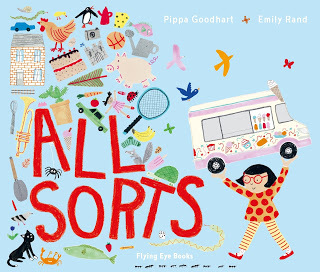
Frankie sorts her toys, the foods and clothes, flowers, trees, vehicles, animals, and then tries to sort people. Hardest of all is sorting herself ...
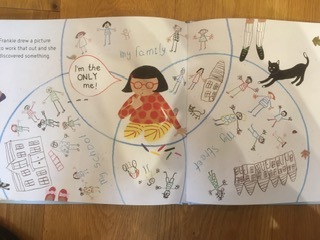
And a happy muddle of life provides the happy ending. After the recent blog on endpapers, I can't resist adding the front and back endpapers for this book, demonstrating some of Frankie's sorting! ...
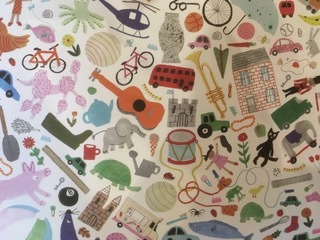
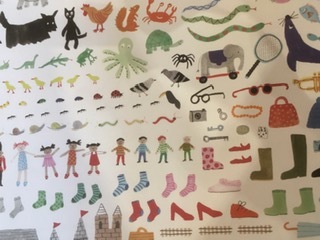
'You Choose Fairy Tales', illustrated by Nick Sharratt and published by Puffin, is the latest in the You Choose series of books which offer lots of choices to consider and talk about. This time the book has a shimmery golden cover, in keeping with its fairy tale theme!
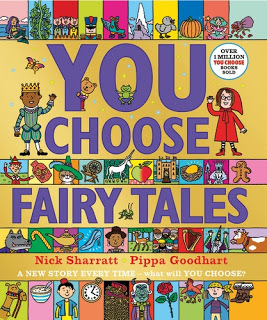
Choose what appeals to you on each spread, and you can create a new fairy tale of your own.
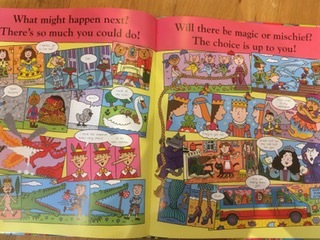
And, again, the endpapers aren't wasted!
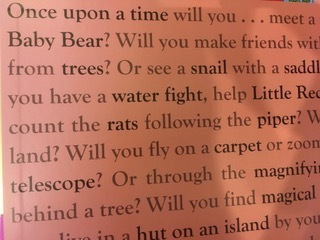
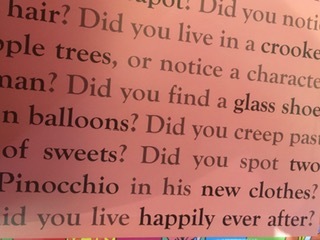
CLARE HELEN WELSH:
'Poo! Is that you?' illustrated by Nicola O'Byrne and published by Macmillan Children's Book, is a non-fiction picture book about Lenny the ring-tailed lemur whose sunny, summer snooze is interrupted by something stinky.
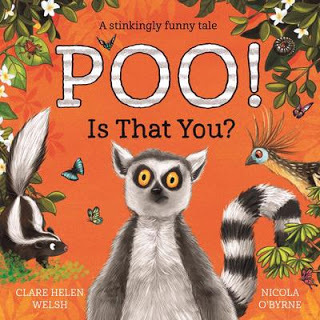
Learn about sloths, stink birds and much more in this book, which cleverly interweaves facts throughout. It also contains an information page at the back of the book, with a photo of each animal.
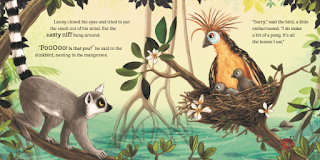
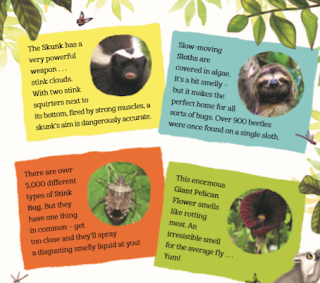
LUCY ROWLAND:
'Wanda's Words Got Stuck'- illustrated by Paula Bowles and published by Nosy Crow.
Wanda the witch is so shy she can't talk at school. No matter how hard she tries, the words simply won't come out. But when another quiet little witch named Flo joins her class, it seems that Wanda's not the only one who gets nervous sometimes. Then disaster strikes at the school-wide magic contest. Will Wanda have the courage to shout out the magic words and save her new friend?
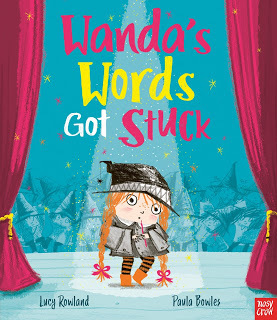
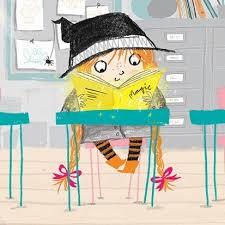
'Rapunzel to the Rescue'- illustrated by Katy Halford and published by Scholastic.
What if Rapunzel saved the prince? In this terrific twist on a much-loved fairytale, a prince with magical hair is saved by a fiercely independent Rapunzel.
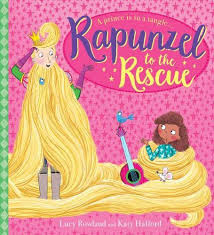
MINI GREY: 'The Book of Not Entirely Useful Advice'- by AF Harrold and published by Bloomsbury.
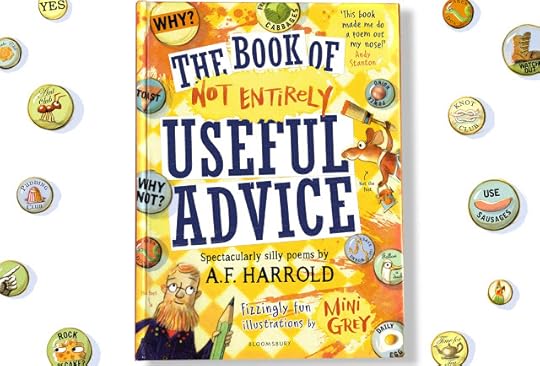
160 pages of poems and advice from AF Harrold and illustrated by me...featuring a lot of food, swearing parrots, bears in your cornflakes and the right number of tigers to have at your picnic. (None.)
 How to avoid escaped giants....
How to avoid escaped giants.... 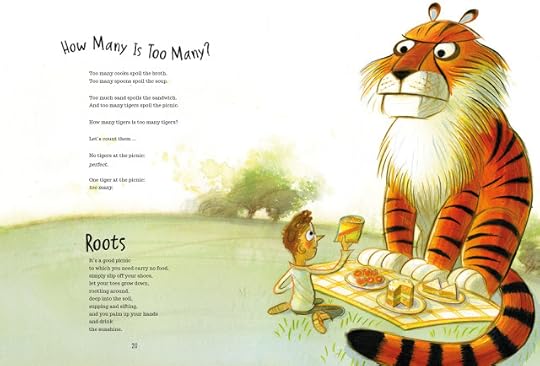 an outbreak of tigers at a picnic...
an outbreak of tigers at a picnic...
 and the perils of shiplofting. Hopefully there's something for everyone here. There's also an absolutely enormous index compiled by AF.
and the perils of shiplofting. Hopefully there's something for everyone here. There's also an absolutely enormous index compiled by AF. Garry Parsons
The Dinosaur That Pooped A Pirate
By Tom Fletcher and Dougie Poynter, illustrated by Garry Parsons. Puffin.
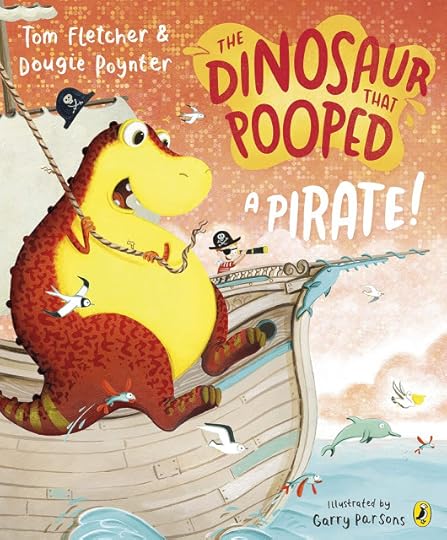
More nonsense shenanigans from Danny and his friendly 'eat everything' dinosaur as they set sail in search of treasure, but will being swallowed by the jaws of the monstrous whale and the perils of skull island be too much for them?
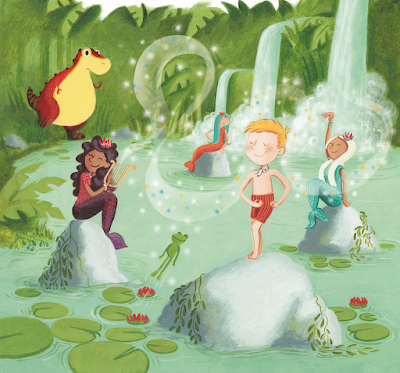

September 20, 2020
AVOIDING THE UGLY by PATRICIA CLEVELAND-PECK
While appreciating that today some of the finest picture books are being produced showcasing the skills and talents of author-illustrators or well-matched writers and artists, I am concerned about a stylistic change which seems to have been taking place over the last few years.
I was particularly struck by this when venturing into the world of early readers. In illustrating these there seems to be a tendency to use bolder colours and unattractive, bug-eyed characters, grotesque animals and unrealistic backgrounds, some veering on the downright ugly. These do echo to some extent, the startling graphics used in television advertising, such as the creatures in the Domino pizza JOMO ads by VCCP or in games such as the late Moshi Monsters.

Some experts to whom I’ve complained about this, simply shrug and say, ‘its what children like now’ or, ‘they are cool and quirky, you wouldn’t want to revert to the cosy Peter and Jane style would you?’ Other simply comment that, ‘ tastes change, it’s a generational thing,’ a dig at the fact that I am very clearly of the granny vintage.
I don’t think any of these are these responses are necessarily true. While garish, unlovely images may be what children now have come to expect, they may well not be what they like. Further, I am not advocating that we step back to the past because in fact plenty of dreadful images were found there too. Nor are all educational publishers guilty. I was delighted by the illustrations by Evelt Yanait in my recent shared reading book, Tutankhamun’s Last Journey, published by Pearson. Evelt’s images are bright, attractive and modern and serve both the story and the reader/listener.
Perhaps the most honest response to my original query was that, ‘it’s too expensive,’ underlining the fact that these reader series are produced on tight budgets. Yes, alas, so much in children’s books is about money - but isn’t it sad if an attractive image is really more expensive than an ugly one?
This trend can also be found in trade publication. Of course I make an exceptions when monsters are the stars, then naturally they need to be, well, monstrous but they can also be appealing as in Ben Court’s gang in Claire Freedman’s Monsters Love Underpants series.
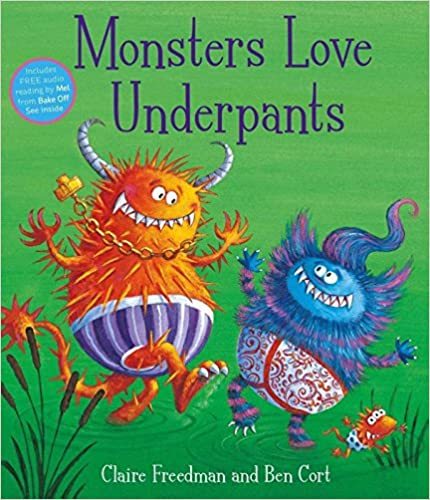
Further, there are of course, numerous brilliant artists producing colourful, witty, up to date images which delight children. Almost anything by Minnie Grey does this, also David Tazzyman with whom I am fortunate to collaborate in my You Can’t Let an Elephant books, while Guy Parker Rees’ illustrations in Giraffes Can’t Dance by Giles Andrea swirl with brilliant colour and fun.

For older children. Inga Moore’s illustrations of The Secret Garden brilliantly capture the enchantment of this classic.

I feel that children, young children especially, need to see beautiful things. I know this raises the question, ‘what is beauty? While this is hard to answer, I feel it is still worth asking on behalf of young children.
Not every child has the opportunity to visit galleries or museums and fewer still live in attractive surroundings full of paintings and elegant objects; all the things which can help shape their aesthetic sense. Some children will also have limited access to books, maybe only seeing and handling them at school.
I know from personal experience that an illustration from a picture book may lodge in a child’s mind for a lifetime. So my plea to editors and designers is simply to give them images of the quality they deserve.
September 13, 2020
CHATTER MATTERS: Picture books featuring characters with SLCN (Speech, Language and Communication Needs) by Lucy Rowland
During the school holidays, I noticed a few people tweeting to ask for recommendations of picture books that feature characters with Speech, Language and Communication Needs (SLCN). Unfortunately, they weren’t always able to find exactly what they were looking for.
Children with SLCN are, I believe, quite under-represented within picture books and yet it is estimated that the prevalence of DLD (Developmental Language Disorder- where children have severe and persisting difficulties with their understanding and use of spoken language) is approximately 7.5% (Norbury et al. 2016). Therefore, in each UK classroom, it is likely that there are, on average, two children who have DLD. Usually there are also other children within the class who have communication needs as a result of different diagnoses e.g. ASD, Learning Difficulties, Down's Syndrome.
Last week, ‘Wanda’s Words Got Stuck’ (written by me and illustrated Paula Bowles) was published by Nosy Crow.
As a Speech and Language Therapist, this book is very close to my heart. It is dedicated to the brilliant NHS Speech and Language Therapy Team in Lewisham, where I used to work.

'Wanda’s Words Got Stuck' isn’t about any one particular communication diagnosis. Our little Wanda could have Selective Mutism? Or perhaps she has DLD and, therefore, has a reduced vocabulary, finds it hard to understand verbal information and struggles to express herself in sentences? She might have a Stammer- her words get stuck and don’t come out easily? Or perhaps she is just very anxious and feels shy about talking in class?
Either way, I wanted to write about a character who finds talking tricky, who finds words sticky. And I wanted to write about how talking is not the only way to communicate and make friends.
‘Some words are meant well but come out all wrong.
Some are important (and ever so long.)
Some words can be brave (even if they’re just small)
And sometimes you find you don’t need words at all’.
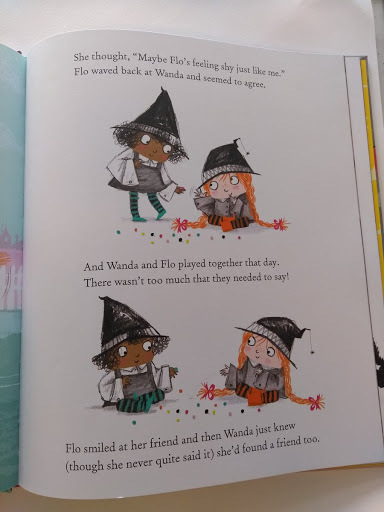
I also knew that I wanted to write a blog post focusing on characters with SLCN in picture books but, I have to admit, that I couldn’t initially find very many! So I do have to say a big THANK YOU here to the twitter world and to everyone who responded to my call for help with their brilliant suggestions. I haven't been able to include every single book here but thank you so much. I really enjoyed researching them.
Talking is not my thing! by Rose Robbins
'The autistic sister in this sibling pair is non verbal, but she finds plenty of ways to communicate and have fun with her brother. Although she can't talk, this little girl understands everything, and has plenty to say, and lots of ideas. Through body language, drawing pictures, making gestures or using flash cards, she is able to contribute to their life together. Her brother and granny are able to understand her whether she needs help or is helping them!'
This is a lovely book highlighting alternative methods of communication.

What the Jackdaw Saw- written by Julia Donaldson and illustrated by Nick Sharratt
'The jackdaw wants all his friends to come to his party, but when he calls out his invitation the animals just touch their heads. Why won't they answer? And what do their actions mean? Luckily a brown owl can help him with the puzzle!
This book about friendship and sign language was created by Julia Donaldson, author of The Gruffalo, with a group of deaf children in a workshop organized by the not-for-profit organisation Life & Deaf which helps deaf children to explore their identities through poetry, film, performance and art.'
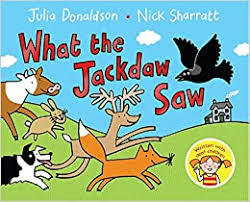
The first time I read this book I knew I had to buy it. I gave it to the Hearing Impairment Specialist in our Speech and Language Therapy Team. It's really great to see sign language being celebrated within a picture book.
Penguin- by Polly Dunbar
'This is the story of Ben, who couldn’t be more delighted to find a penguin friend inside his present. “Hello, Penguin!” he says. Penguin says nothing. Ben tickles Penguin, pulls his funniest face, puts on a happy hat, sings a silly song and does a dizzy dance ... but still Penguin says nothing. It isn’t until a passing lion intervenes that Penguin finally speaks – and, when he does, Ben discovers that some things are worth the wait. '
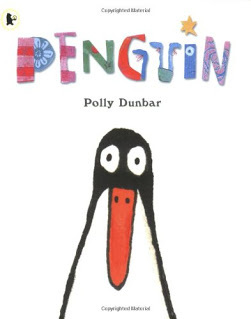
I love this picture book! It's a real classic and reminds me of some of the children I have worked with who can be so quiet and shy until you find the key (communication method, motivator, relationship or subject matter) that unlocks their voice!
I Talk like a River- written by Jordan Scott and illustrated by Sydney Smith
'When a boy who stutters feels isolated, alone, and incapable of communicating in the way he'd like, it takes a kindly father and a walk by the river to help him find his voice. Compassionate parents everywhere will instantly recognize a father's ability to reconnect a child with the world around him.'

This book isn't out until September but it looks absolutely beautiful and I have heard very good things about it! I thought the illustrations by Sydney Smith in 'Town is by the Sea' were stunning and these look totally wonderful too. It is so important that children who stutter are able to see themselves and their experiences represented within the books they read.
Another recommended picture book, featuring a character with a stutter, was 'A Boy and A Jaguar' written by Alan Rabinowitz and illustrated by Catia Chien.

Boy- written by Phil Cummings and illustrated by Shane Devries
'The king’s battles with the dragon were always mighty and loud. Boy lived in silence and couldn’t hear the fighting. But Boy could see the fear around him… and how everyone would be much happier without it.'
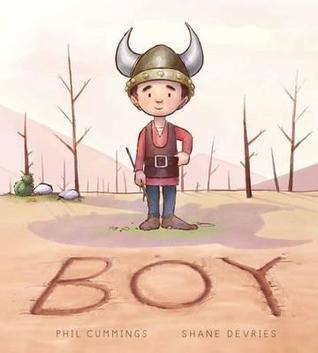
A picture book featuring a boy who is deaf. Unfortunately, I was not able to source this book from my book seller in the UK, but a few different people recommended this one and highlighted it as good for exploring communication breakdown.
El Deafo by Cece Bell
'El Deafo is a funny, deeply honest graphic novel memoir for middle graders. It chronicles the author's hearing loss at a young age and her subsequent experiences with a powerful and very awkward hearing aid called the Phonic Ear. It gives her the ability to hear--sometimes things she shouldn't--but also isolates her from her classmates. She really just wants to fit in and find a true friend, someone who appreciates her, Phonic Ear and all. Finally, she is able to harness the power of the Phonic Ear and become "El Deafo, Listener for All." And more importantly, declare a place for herself in the world and find the friend she's longed for.'
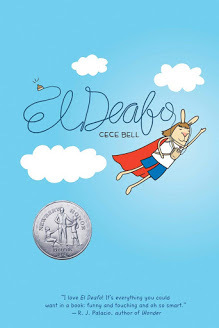
The Bear who Stared- by Duncan Beedie
'There once was a bear who liked to stare... and stare... and STARE.
Bear doesn't mean to be rude, he's just curious but too shy to say anything. But nobody likes being stared at and it soon gets Bear into trouble. Luckily a goggly-eyed frog helps Bear realise that sometimes a smile is all you need to turn a stare into a friendly hello.'
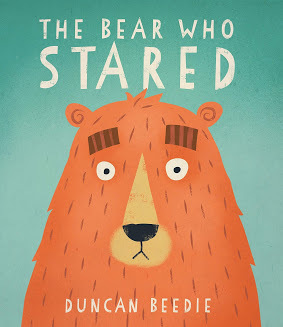
Perfect for children who have difficulties knowing how to initiate conversation and play. Sometimes the children I worked with just needed a bit of support to know how to join in and make friends.
Duncan Beedie's new book 'Oof makes an Ouch', which I bought for the purpose of writing this blog post, is also about communication and has a lovely section about some of the behaviours that we sometimes see when children don't yet have the right words to communicate their emotions.
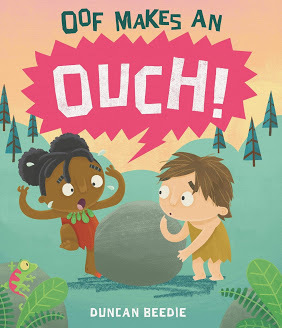
I go quiet by David Ouimet
'I Go Quiet is the exquisite story of an introverted girl, struggling to find her place in a noisy world. Through the power of books, creativity and imagination, she begins to see possibilities for herself beyond the present, to a future where her voice will finally be heard.'
A book for older readers, the words read 'When I speak, I'm not understood. So I go quiet.' This reminds me so much of some of the children I worked with in a specialist Language Resource Base in London. It is vital that there are books like this highlighting the difficulties that some of these children face.
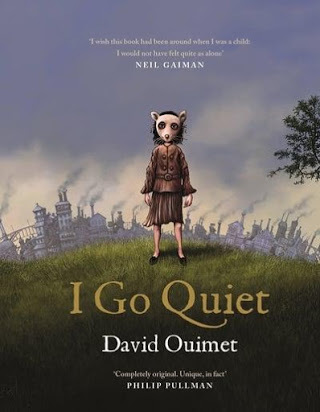
For this blog post, I also explored picture books which use alien characters as a way of dealing with those feelings that children with SLCN often experience- of not understanding, of not being understood and of not belonging. These books are also good for exploring other methods of communication. For example, use of non-verbal communication such as gesture, body language and facial expression. Some of the books that fall into this category are:
Krong by Garry Parsons
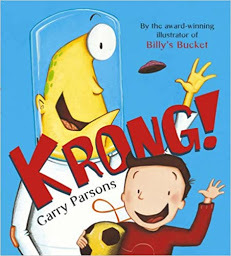
The Cow Who Fell to Earth by Nadia Shireen (which I also treated myself to as part of the research for this blog post and it's great!)
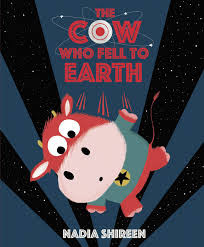
Beegu by Alexis Deacon
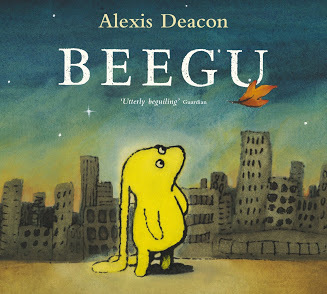
Of course, picture books don't have to use alien characters to explore these themes. Chatterbox Bear by Pippa Curnick is the tale of Gary the Bear who is a real chatterbox until he finds himself on an island full of birds, who don't speak 'Bear', and must learn to communicate in other ways.
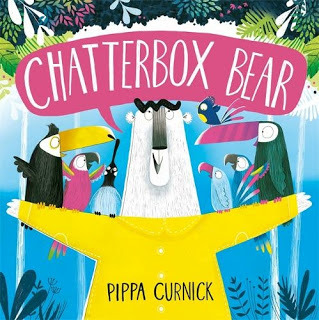
All the Ways to be Smart written by Davina Bell and illustrated by Allison Colpoys
'Celebrates the myriad ways for kids to be smart--being empathetic, artistic, athletic, and inquisitive.
A tender, funny, and exquisitely illustrated picture book celebrating all the unique and wonderful qualities that make children who they are.'

Whilst this book does not explicitly feature children with SLCN, I wanted to include it because it has SUCH a wonderful message. The children I worked with often focused on what they struggled with, what they couldn't do. Some of the most important work that their therapists and specialist teachers did was to support them to focus on and celebrate their individual strengths. This book reads....
Smart is not just ticks and crosses,
smart is building boats from boxes.
Painting patterns, wheeling wagons,
being mermaids, riding dragons...
I really hope that the books discussed in this post can be shared and enjoyed with children who, for whatever reason, are struggling to find their voice.
Please do comment below with any suggestions of books I have missed. I would love to find more picture books featuring characters with SLCN. Thank you.
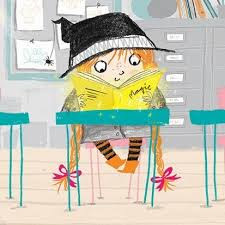
Wanda's Words Got Stuck
written by Lucy Rowland
illustrated by Paula Bowles
published by Nosy Crow.
September 6, 2020
The life of a picture book by Jane Clarke
But what is comforting is that a picture book’s life doesn’t end when it is no longer in print. Hopefully a family somewhere will treasure a copy and it will last a lifetime - or more.
W-aaa-y back in 1986, when my sons were celebrating their 1st and 3rd birthdays (in the same week), their Grandma and Grandpa brought them the gift of a bright, shiny new copy of (the now out of print) Henry’s Busy Day written and illustrated by Rod Campbell. (Viking Kestrell 1984).
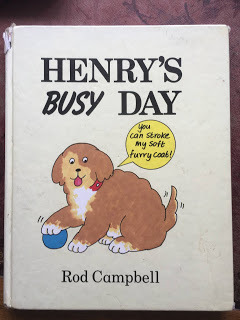
In my mind’s eye I can still see my mother sitting on the sofa between them, sharing it with them. It has very simple text and illustrations, but it’s full of warmth and affection. We read it to them time and time again.
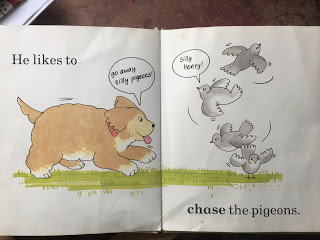
My sons first recognised words in it, so it helped them begin to understand and join in with the process of reading. It was so loved, it was impossible to part with it when the boys grew older. It sat on a shelf for years, untouched, weathering the deaths of their grandparents and their father.
And then along came my sons’ children…
and now I get to read the same book to my 4 granddaughters, and they love it too.
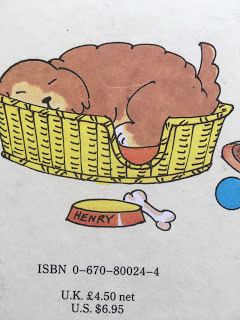
I see from the back that the book cost £4.50, which was quite a lot in 1984 (in relative terms more than picture books cost today), but the memories it brings with it are priceless.
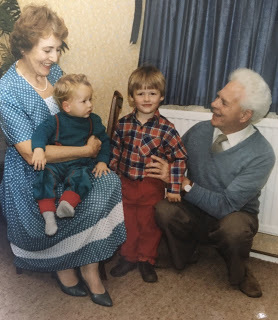 2 small birthday boys with their grandparents 1986
2 small birthday boys with their grandparents 1986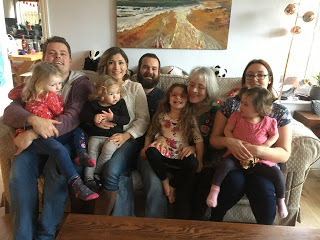 2 big boys with their partners, children (and me) pre-pandemic Xmas
2 big boys with their partners, children (and me) pre-pandemic XmasAmazingly the ‘soft, furry coat’ advertised on the cover has survived all the love, though it does need freshening up occasionally with a bit of hand sanitiser. Well, don’t we all these days?
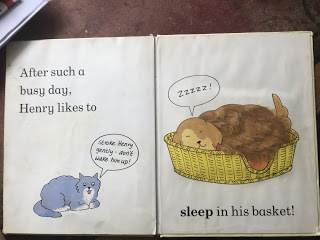
Jane hopes that someone, somewhere is treasuring a tatty old copy of one of her picture books.
August 31, 2020
Under the Covers - The unique story of the endpaper in picture books - Garry Parsons
Enthusiasts of picture books will be familiar with the delights that may lie hidden on the inside cover of a hardback book, but endpapers often go unnoticed and uncelebrated. With the help of two renowned picture book designers, illustrator Garry Parsons takes a look at the humble endpaper and uncovers reasons to celebrate them.
Endpapers, also known as ends or endsheets, are the pages glued into the inside cover of a hardback book. The functional purpose of these pages is to hold the book’s interior to its cover and protect the insides of the book. But these pages can also be the source of creative visual delights. A home for maps, patterns and repeats, bold colours or graphic jokes. A space for information about its creators or a place to entice the book owner to add in their own name, the rare occasion when we are permitted to write inside a book. Endpapers can set a scene, form part of the book’s narrative or simply hint at what is to come. So, despite their practicality, these pages can surprise and inspire.

Originally, the endpapers would be white and simply form part of the book’s physical structure, but by the 18thCentury patterns and swirls became popular through the process of marbling or marbleising. Made by floating colours onto a bath of gum or marbleising size, the pattern on the surface of the liquid can be transferred onto paper.
Techniques using combs with varing degrees of spaced teeth could be used to rake the colours on the surface into complicated-looking patterns and swirls. With names like ‘peacock’ and ‘bouquet’, the humble endpaper began a life of its own.
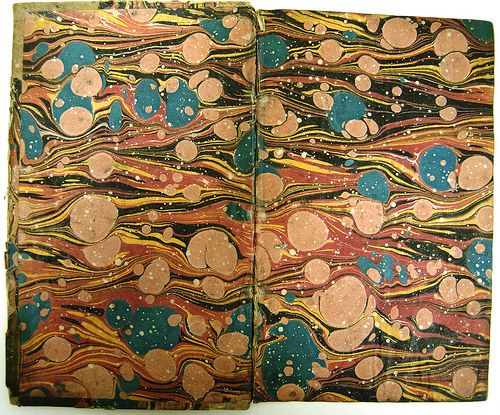

Later, book-makers began experimenting with block printing techniques to add decoration to the end sheets and when book binding became mechanised in the 1830s, the decorative nature of endpapers changed again, becoming ornate with patterns and repeats of floral and animal motifs.
 Block printed endpapers from Anton Michelitz 'Scrutinium Hypotheses Spirituum Animalium' 1782.
Block printed endpapers from Anton Michelitz 'Scrutinium Hypotheses Spirituum Animalium' 1782. From a copy of Voltaire's Gospel of the Day 1772-3
From a copy of Voltaire's Gospel of the Day 1772-3Towards the end of the 19thCentury, endpapers became decorated with visual suggestions of the book’s subject matter with children’s picture books in the early 20th Century starting to use illustrations of the characters within the story or depictions of maps from the narrative.
 The Fairy Tales of the Brothers Grimm illustrated by Arthur Rackman
The Fairy Tales of the Brothers Grimm illustrated by Arthur Rackman  Girl Scout Handbook 1938
Girl Scout Handbook 1938Influences of the endpaper’s history echo in the repeats and patterns of our picture books today and allow an opportunity for extra artwork from the book’s illustrators and designers.
As an illustrator myself, I enjoy this additional space to be creative and the chance to collaborate with the book designer on what approach might work best. A chance to create an extra level of surprise that will enhance and lift the book a little further. Whilst considering an approach for the endpapers usually comes after the main body of a picture book is drawn up and layed out, the end paper design often feels like an added bonus to tie the whole book together, metaphorically as well as structurally.
In my view, each turn of the page in a picture book should give the reader something unexpected, a visual surprise each time, and the endpapers are no exception.
As a child I remember tracing my finger around the curves of the elephants on the endpapers of Jean De Brunhoff’s adventures of Babar or pouring over the fully rendered scenes of Rupert and his pals in the Daily Express’ Rupert Bear Annuals.
 Jean De Brushoff 'The Story of Babar the Little Elephant' 1934
Jean De Brushoff 'The Story of Babar the Little Elephant' 1934 Rupert. The Daily Express Annual 1973 with endpaper illustrations by Bestall
Rupert. The Daily Express Annual 1973 with endpaper illustrations by BestallSo the endpapers to me feel like special creative places where designer and illustrator can merge ideas, where there are few rules and many choices, all held together by a rich tradition and a respected history.
Sifting through the shelves of my collection of picture books, I have looked at the variety of ways they have been used and pulled out a view favourites.
David Roberts has returned to marbling in his compelling retelling of the history of the Suffragette movement.
 Endpapers from 'Suffragette, the Battle for Equality' by David Roberts 2018
Endpapers from 'Suffragette, the Battle for Equality' by David Roberts 2018While Millie Marotta’s endpapers in A Wild Child’s Guide to Endangered Animals and Coralie Bickford-Smith’s endsheets in The Worm and the Bird remind us of the repeated block printing process.
 Endpapers from 'A Wild Child's Guide to Endangered Animals' Millie Marotta 2019
Endpapers from 'A Wild Child's Guide to Endangered Animals' Millie Marotta 2019 Endpapers from 'The Worm And The Bird' Coralie Pickford-Smith 2017
Endpapers from 'The Worm And The Bird' Coralie Pickford-Smith 2017Endpapers can introduce the reader to the characters they are about to meet. Often echoing past printing techniques, these can be monotone and follow the tradition of repetitive wallpaper patterns, as in these examples from Jon Klassen’s hilarious 'I Want My Hat Back' and the informatative ‘Wild Animals of the North' by Dieter Brown and Alastair Humphrey’s ‘Great Adventure’.
 Endpapers from Jon Klaassen's 'I Want My Hat Back' 2012
Endpapers from Jon Klaassen's 'I Want My Hat Back' 2012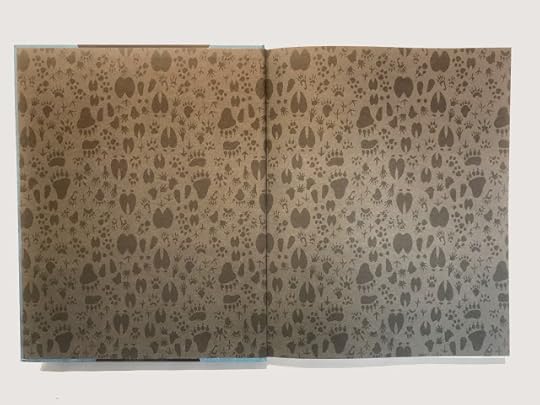 Endpapers from Dieter Braun's 'Wild Animals of the North' 2016
Endpapers from Dieter Braun's 'Wild Animals of the North' 2016 Endpapers from Alastair Humphrey's 'Great Adventures' 2018
Endpapers from Alastair Humphrey's 'Great Adventures' 2018The tradition of the wallpaper pattern repeat is used by Lauren Child in ‘Who Wants to be a Poodle, I don’t,’ a book with an interior full of wallpaper-like patterned collages.
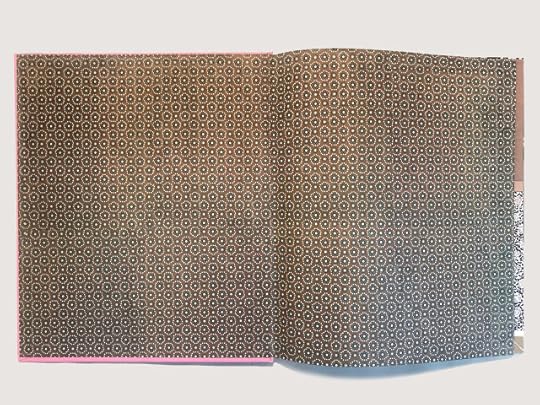 Endpapers from 'Who Wants to be a Poodle, I Don't' by Lauren Child 2009
Endpapers from 'Who Wants to be a Poodle, I Don't' by Lauren Child 2009I love the subtle and poetic ways of visual storytelling in the endpapers of 'The Tea Party in the Woods' and 'Lawrence in the Fall'.
These drawn objects taken from the narrative make curious collections, adding surprise and curiosity before reading the book and leaving a space for you to consider them after reading.
 Endpapers from 'The Tea Party in the Woods' by Akiko Miyakoshi 2010
Endpapers from 'The Tea Party in the Woods' by Akiko Miyakoshi 2010 Endpapers from 'Lawrence in the Fall' by Matthew Farina and illustrated by Doug Salati 2019
Endpapers from 'Lawrence in the Fall' by Matthew Farina and illustrated by Doug Salati 2019Endpapers are also traditionally the home of illustrated maps like these beautifully clever pages from Peter Sis in his picture book ‘Tibet, Through the Red Box’ and M. Sasek’s comical ‘This is the Way to the Moon’ children’s classic from 1963.
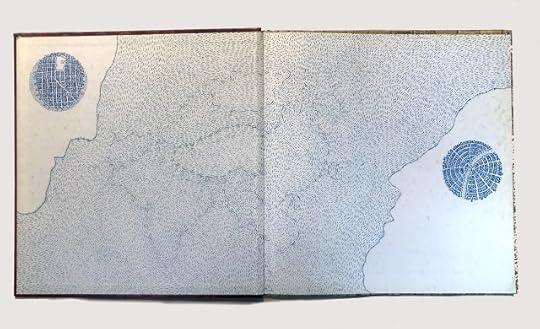 Beautifully clever endpapers from 'Tibet Through the Red Box' by Peter Sis 1998
Beautifully clever endpapers from 'Tibet Through the Red Box' by Peter Sis 1998 Endpapers from 'This is the Way to the Moon' by M Sasek 1963
Endpapers from 'This is the Way to the Moon' by M Sasek 1963Endsheets can be gloriously bold and abstract as in Eric Carle’s ‘From Head to Toe’ or wonderfully graphic in ‘Professor Astro Cat’s Human Body Odyssey’.
 Eric Carle's endpapers for 'From Head To Toe' 1997
Eric Carle's endpapers for 'From Head To Toe' 1997 Endpapers from 'Professor Astro Cat's Human Body Odyssey' 2018
Endpapers from 'Professor Astro Cat's Human Body Odyssey' 2018And endpapers can also act as a space for holding information like the amusing and decorative ‘List of Reasons to Read this Book’ from ‘The Liszts’ or somewhere to assert your ownership in ‘Going to The Getty’ by Otto Siebold and Vivian Walsh.
 From 'The Liszts' by Kyo Maclear and illustrated by Julia Sarda 2016
From 'The Liszts' by Kyo Maclear and illustrated by Julia Sarda 2016 'Going to the Getty' illustrated by J.Otto Semibold and written by Vivian Walsh 1997
'Going to the Getty' illustrated by J.Otto Semibold and written by Vivian Walsh 1997Akin to a clever title sequence from a loved movie or the surprise boldness of an inside lining of a good suit, endpapers in picture books can deliver clever, subtle, elegant and evocative messages and hold a special place for us enthusiasts. I asked two picture book designers and endpaper admirers, Ness Wood and Becky Chilcott, to share their thoughts on what makes a great end sheet and pick out a few of their all time favourites.
Ness Wood has chosen to share an example of endpapers being used as narrative, pure pattern and abstract.
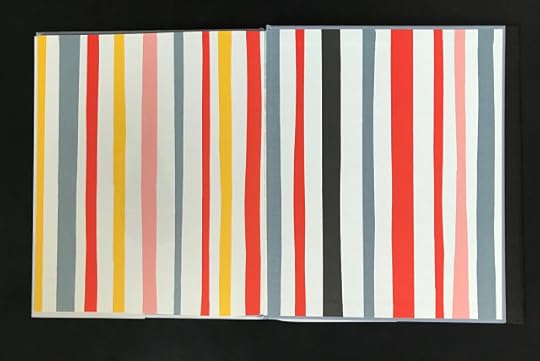 'Sparkle and Spin' by Ann and Paul Rand
'Sparkle and Spin' by Ann and Paul RandSparkle and Spin by Ann and Paul Rand
I love the graphic quality of these gorgeous endpapers. Originally published in 1957, this timeless classic is such a fun carnival of colour.
The uneven quality of the stripes works so very well indeed.
 Front endpapers from 'I'm Actually Really Grown Up Now' by Maisie Paradise Shearing
Front endpapers from 'I'm Actually Really Grown Up Now' by Maisie Paradise Shearing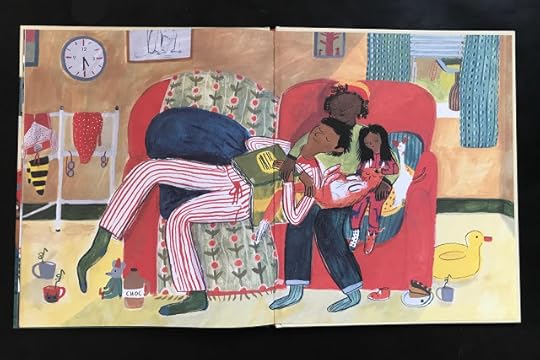 Back endpapers from 'I'm Actually Really Grown Up Now' by Maisie Paradise Shearing
Back endpapers from 'I'm Actually Really Grown Up Now' by Maisie Paradise ShearingI’m Actually Really Grown Up Now by Maisie Paradise Shearring
A great contemporary example of narrative endpapers - setting the scene at the beginning and having the family unit asleep on the ends.
Gorgeous use of colour and composition.
 'Another' by Christian Robinson
'Another' by Christian Robinson

Another by Christian Robinson
This wordless book is fun, fun, fun! A riot of ripped paper and texture, Robinson is the fabulous creator of these amazingly simple but gorgeous images.
The endpapers show the night sky in all its glory - which is what the little girl can see through her telescope at night. I have also included what is under the jacket- the amazingly brilliant red glory of kids playing - he makes it look so simple!
And here are Becky Chilcott’s choices.
I love the endpapers in a book – from a reader and designer’s point of view. It’s a chance to add something extra to the book that can be narrative, decorative or ideally both and I feel can be somewhere the illustrator can play more freely in terms of style and content. Of course on each book it really varies as to who creates and comes up with the ideas for them – it can either be the designer or illustrator and is more often than not a collaborative effort.
I love the possibilities of coming up with ideas for endpapers along with choosing things like head and tail bands and cloth colours for the book’s binding – it’s like putting the final touches on a cake and adding the cherry on top. I think it’s just as important to pay attention to these details as it is the whole package that the reader experiences – not just the cover and story inside. By paying as much attention to these details, you can make their experience richer.
As a reader, I love picking up a book for the first time, opening it up – and the endpapers are often the first thing you see. If they’re illustrated rather than a plain coloured paper, it feels more inviting and is a visual signpost to the contents within, leading you to a new world waiting to be explored . . .
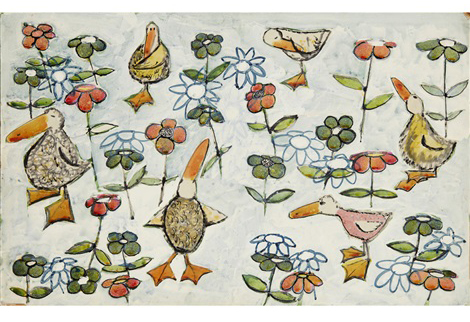 Endpapers from John Burningham's 'Borka'
Endpapers from John Burningham's 'Borka'Borka by John Burningham
I adore this book – John’s illustrative style is so free and playful, I feel like the characters are about to flap off the page! The endpapers set up the story so simply and clearly here by indicating that Borka is different from the rest of her siblings and it makes you curious as to what happens to her in the rest of the book. The limited colour palette is gorgeous too – I wish I could hang this on my wall.
 Front endpapers from 'Little Mouse's Big Book of Fears by Emily Gravett
Front endpapers from 'Little Mouse's Big Book of Fears by Emily Gravett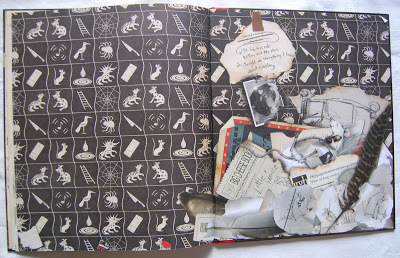 Back endpapers from 'Little Mouse's Big Book of Fears by Emily Gravett
Back endpapers from 'Little Mouse's Big Book of Fears by Emily GravettLittle Mouse’s Big Book of Fears by Emily Gravett
These endpapers are stunning. I love that they reference the traditional nature of endpapers with a decorative pattern – but comprising of things that people are afraid of – combined with narrative elements from the story – showing Mouse, looking scared, leading us into the book holding a pencil, along with the torn paper instructions for the book and die-cut hole from the cover. I really like that the endpapers at the back reference the ones at the beginning with the same pattern but showing Mouse looking relaxed and happy in the nest of all the bits of paper that have been nibbled from the book. It finishes off the story perfectly.
 Endpapers from Little Golden Books
Endpapers from Little Golden BooksLittle Golden Books
The endpapers from the Little Golden Books series were designed to featured in each book in the series and showcase characters that can be found within the different books. I love the typography, pattern, colours and whimsy of them – they fill me with nostalgia and I like that they aren’t too perfect with the series logotype falling over some of the illustrations or getting too close to them, which is something I would probably never consider doing today!
Ness Wood is a respected freelance book designer and co-founder of Orange Beak Studio, who offer one-to-one tutorials, mentoring, portfolio surgeries, workshops plus editorial advice for illustrators. www.orangebeak.com or follow them on instagram.
Becky Chilcott is a freelance graphic designer and the curator of the events programme at the St Bride Library in London.
Garry Parsons is an illustrator of many picture books and an enthusiast of endpapers. You can see more of his work at garryparsons.co.uk
August 19, 2020
Trying to get serious without getting preachy. A picture book on consent by Juliet Clare Bell
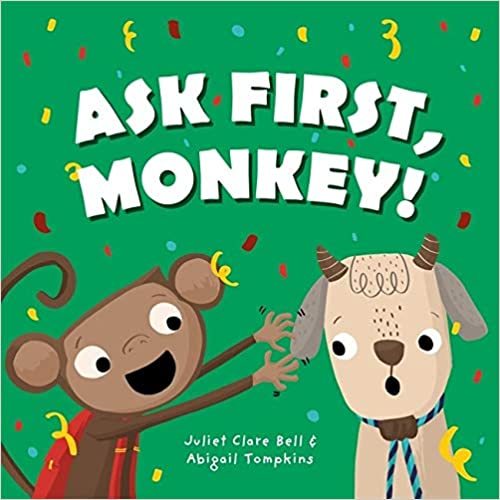
ASK FIRST, MONKEY! (Juliet Clare Bell and Abigail Tompkins, Jessica Kingsley Publishers, 2020)
In June 2016, I wrote a blogpost for Picture Book Den about empathy in picture books. I felt compelled to write it in the wake of the Stanford Sexual Assault trial that had just been widely reported on, and what it had brought up for me in relation to my own experience many years before that. Garry Parsons from the 'Den has also written about empathy in an important recent post here, too and in it we can see his latest, glamorous new book
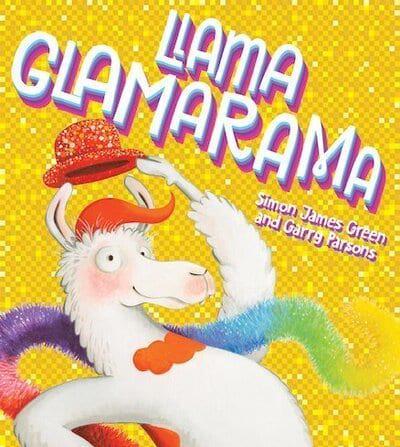
Llama Glamorama (Simon James Green and Garry Parsons, Scholastic, 2020)
Back in the 2016 post I looked at about thirty picture books which were great for encouraging empathy in young children, but what I didn’t find was a single fictional picture book (looking like a typical picture book) that specifically looked at consent. There were lots of recommendations from other people in the comments about excellent picture books encouraging empathy but the only ones about consent were very educational and formal-looking. The final comment was from my agent: ‘Let’s discuss’. And we did (I was already plotting and scribbling).
Cut to four years later, and ASK FIRST, MONKEY! illustrated by Abigail Tompkins and published by Jessica Kingsley is here. It’s a book I was extremely keen to write (because I couldn’t find what I was looking for) but also extremely nervous. I’d love to hear from other writers and illustrators who are trying to create, or have created, picture books on tricky issues with the issues you faced, but in case it’s of help to anyone, here are the some of the issues I tried to grapple with…
ANIMALS AS CHARACTERS
Clare Helen Welsh posted here just last week about using animals as characters in picture books. It reminded me that this is my only published book to date that uses animals –and it’s for a very specific reason. Clare’s last point about using animals is that reason: safe spaces. Using animals as characters creates a little bit of distance for the child reader so that we can tackle tricky subjects in a gentler way.
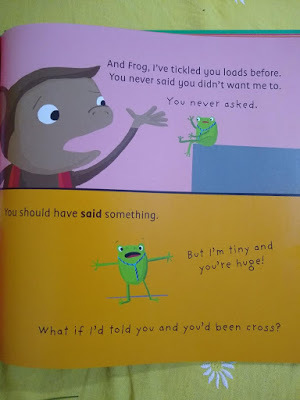
(c) Juliet Clare Bell and Abigail Tompkins (Jessica Kingsley Publishing, 2020)
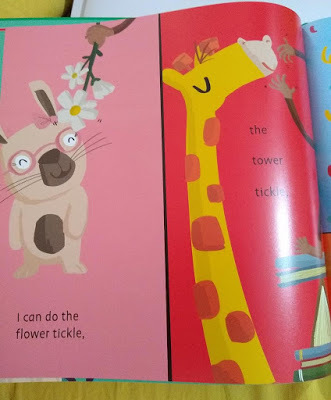
others don't:
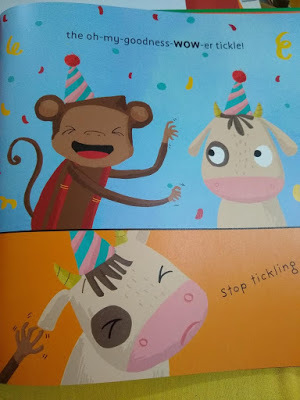
(c) Juliet Clare Bell and Abigail Tompkins (Jessica Kingsley Publishing, 2020)
There are wonderful examples of using animals as characters, including one of my favourites
Debi Gliori’s beautiful No Matter What about love and death.
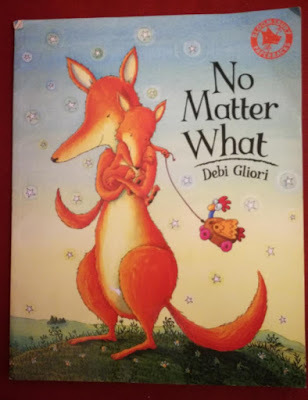
(c) Debi Gliori
This doesn’t mean that we should always shy away from tackling big issues with human characters. In fact, I very deliberately used human characters in a book about death and dying (Benny's Hat, illustrated by Dave Gray)
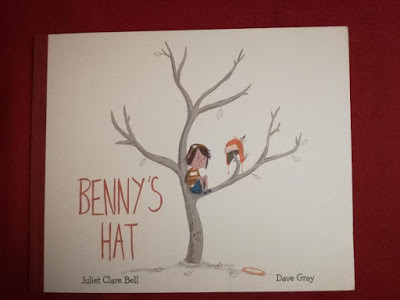
(c) Juliet Clare Bell and Dave Gray
but for the subject of consent, I knew I wanted to use animals and I was really inspired by Ed Vere and his books, like Grumpy Frog:
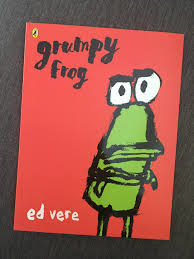
(c) Ed Vere
and others in that style, like Morag Hood's I Am Bat:
(c) Morag Hood
and Steve Antony's Please Mr Panda:
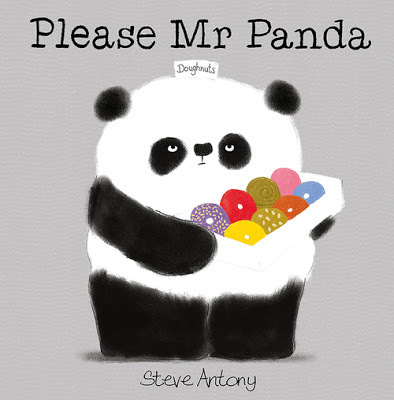
(c) Steve Antony
HUMOUR
Who is your book aimed at? If you’re genuinely trying to get a message across to a specific audience, it’s really important to honour that audience and create something that will appeal to them (and not just the people who will be reading the book to them). If there’s a really important point you want to get across, and you can do it with humour and compassion, a child may be more likely to take on board that message. If you're writing with a specific audience in mind, it doesn't mean that the book is not for other readers, too, but it really helps you focus on the best style for the story.
In ASK FIRST, MONKEY! I was aiming the story at children who have not yet grasped, or not quite grasped, the concept of boundaries and consent (Monkey in this story). I wanted for these young people to find Monkey funny and relatable –and not to be judging him. Consent needs to be taught and Monkey hadn't been taught. He's still going to have fun after he starts practising consent -and so will the reader. And the fun will not be at anyone else's expense. I really hope that by using humour, young children will learn alongside Monkey and recognise themselves when he gets it wrong and not feel shamed by their own actions but see a new way of behaving.
SIMPLICITY
I love picture books that manage to do things apparently simply. So often, they’re by author-illustrators
like David McKee's classic, Not Now, Bernard
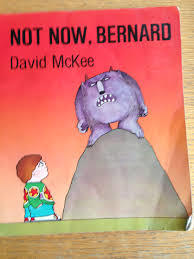
(c) David McKee
and of course Ed Vere, Morag Hood, Steve Antony, above, and Mo Willems, etc.
I was really keen from the start for the book to be speech only. This makes it easy to act out (at school or at home), you get even more of a sense of character, perhaps, and it’s simple, with fewer words. Dan Santat pulls it off brilliantly with his The Cookie Fiasco:
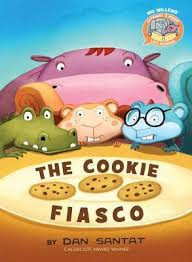
(c) Dan Santat
(you can watch it being acted out with all the voices, here)
But there’s a certain amount of pride involved in letting go of what you think would be funny and clever, versus what you think is right for the story. My original name for the book was
Tickletastic Funky McMonkey Does Not Want An Ice Cream!
I loved Don’t Let The Pigeon Drive The Bus
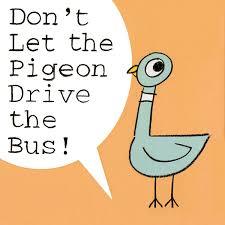
(c) Mo Willems
It was a really fun and funny title and I wanted my book to be fun and funny, and what better way than a funny, long title?
Well, clearly there wasa better way. The ice cream element of the story was dropped very quickly after my agent, James Catchpole, thought it wasn’t relevant enough (I was disappointed for a few days but he had a good point). Funky was dropped when the publisher pointed out that Funky means smelly in American! McMonkey, well that was too similar to a fast food chain, it turned out… and so on. I even called one draft Tickles, Pies and Spinny Surprise (though the story changed again after that)... It took a long time to get to it simply being called Ask First, Monkey! It was simple and to the point but I fought against it (mostly with myself)–because of pride. Wasn’t that too obvious? Too in your face? Too preachy? Not funny? Fortunately other people who know the business better than I do were there to do their job. This book came from a very strong desire to help young children who don’t yet get boundaries and consent, get it, and to grow into adults who get it. And that can mean taking a strong dose of getting over yourself to get it into the hands of those you reallywant it to get into the hands of.
Launching a book during summer 2020 is a strange (and often deflating) thing as many writers and illustrators know. I was looking forward to going into schools and doing lots of sessions with animal puppets (and singing?!) to look at consent and boundaries in a fun, and safe, way. There will be a song eventually but it’s been put back by a few months because it’s hard to travel and work with the singer-songwriter at the moment, which was disappointing, but it’s still going to happen. And I still hope to do some events with Abigail Tompkins, the illustrator who captured the expressions that were so critical to a speech only book so well. Consent is a subject very close to my heart and we’ll get there with all the accompanying visits/songs/events eventually.
But it’s not all bad –my daughter and her friend have been able to make a stop motion animation of the story, using toys we found on holiday in Orkney. Here’s the fruit of their labours:
The book was written before the Me Too movement, but picked up by a publisher after. With the massive and very welcome emphasis on consent in the past few years, this means that there are now a few other picture books on consent either just coming out or soon to be out, which I’m very much looking forward to reading.
Which picture books do you think work really well for dealing directly with a tricky topic? Please let us know in the comments section. Many thanks, Clare.
Juliet Clare Bell is a children’s author of more than thirty books already out or in press. In a former life (before children) she was a research developmental psychologist.
August 9, 2020
Using Animal Characters in Picture Books by Clare Helen Welsh
Animal characters are hugely popular in picture books and there are many reasons why creators star them in their stories. But what are the pros and cons of using animal characters vs human characters and what do we need to know?
After being invited to talk about animals in picture books at a really fun #ukpbchat event, I put all my thoughts down in a post for Picture Book Den. And because I have a talent for making things more complicated than they need to be, I’ve arranged them in a suitable acrostic poem!
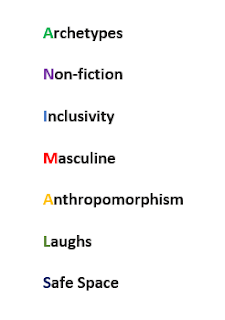
Archetypes :
Animals often come with pre-packaged personalities. For example, foxes are thought to be sly, bears live in caves, mice are small and eat cheese. When creating a picture book character these are useful because they can help a character feel familiar to a child. The advantage of this is that young children can open a book and quickly get a sense of the story. Picture book characters need to be relatable, so using archetypes can help.
However, the market is flooded with books that include foxes, bears, dogs, cats, rabbits, mice and wolves. I find there’s something exciting about subverting archetypes and turning these stereotypes on their head to create something new and more original.
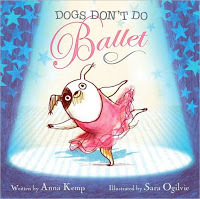
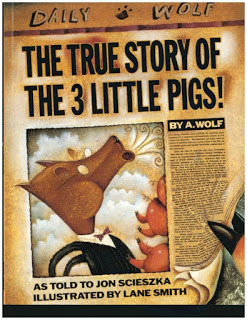

(Note: It might be worth bearing in mind that there could be a very good reason why some animals do not feature highly as picture book characters! For example, pigs and hedgehogs might not have the global appeal publishers are looking for.)
Non-fiction:
Animals are cute, engaging, fascinatingand lots of fun to read about! For these reasons, animal characters are a great place to start if you’re looking to write non-fiction picture books. This was how my foray into non-fiction began and I have now sold five non-fiction narrative texts about animals. They can be funny, poetic or anything in between. Here’s one of mine that came out most recently. It’s the first in a series with MacMillan, illustrated by Nicola O’Byrne.
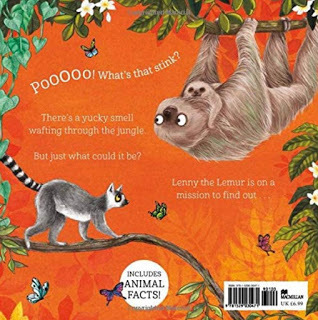
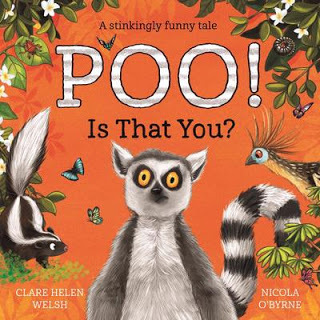
Anthropomorphism :
Anthropomorphism is defined as the attribution of human characteristics or behaviour to an animal or object and it’s a little bit marmite with publishers as far as I can gather. I’ve written picture books where the animals speak and wear clothes, and some where they do not. I have some where humans and animals talk to each other, and some where no one talks. There really is a huge range. It would be worth researching the kinds of books a publisher has on their list to see where they sit on the anthropomorphic scale. And do bear (Ha!) in mind that it can vary depending on what type of picture book you’re looking at.
For one of my non-fiction stories publishing in 2021, I was asked to tweak lines that anthropomorphised the animal protagonist, too much. On the other hand, Lenny is publishing with a different publisher and is a walking, talking ring-tailed lemur on holiday in South America! However, I do know that Nicola was asked to make the style realistic and she worked tirelessly on the setting to ensure authenticity, the reason being that biologically accurate books help children to learn and retain knowledge about the animals involved.

Laughs:
We’ve established that animal characters are instantly relatable and come with their own set of character traits that authors can use and subvert. ‘This Book has Alpacas and Bears’ by Emma Perry and Rikin Parekh is a great example of subverting the trope that bears make great book characters. Rikin’s illustrations are a suitable witty match for Emma’s text. Jim Field and Kes Gray’s ‘Oi’ series and Mo Willem's Pigeon books are also packed with giggles!
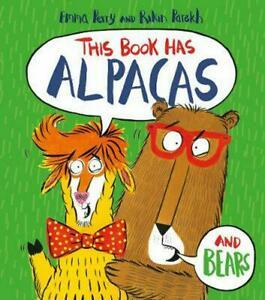
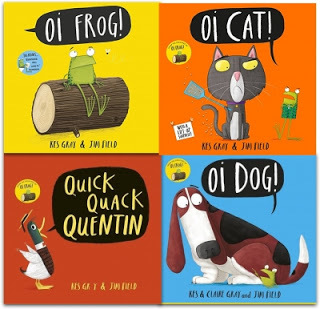

Inclusion :
Animals are easy to empathise with – everyone can see themselves in an animal character. The potential for animal characters is that all children can see themselves in books. That’s not to say they should be replacing diverse human characters. NOT AT ALL. We desperately need to see more diverse human characters in children’s stories and the industry appears to be slowly moving towards representing and celebrating different backgrounds. There's much more work to be done, but certainly one of the positives of animal characters is that they are inclusive.
Masculinity :
Historically, animals are often referred to as masculine. It’s always worth looking at your characters to see which sexes they identify with. How many of your stories have female protagonists? Male? Are animal main characters more or less likely to be male? I made a little table of my published texts. The results were surprising!
Animal protagonist Human protagonist Female protagonist
1 5 Male protagonist
6 7
Androgynous (at point of submission) 3 5
These are published (or soon to be) titles. I’d hope that in my desktop files there are more books with female, animal protagonists. Michelle Robinson and Deborah Allright have created a great example of how to switch up stereotypes in She Rex! Also look out for Rashmi Sirdeshpande and Diane Ewen's, 'Never Show a T-Rex A Book,' which features a female dinosaur character.
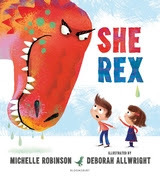
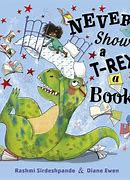
Safe spaces : A big positive of using animal main characters, is that creatives can use the distance between the child reader and protagonist to explore darker and more scary themes. In Isabel Thomas’ new book for example, children learn what happens to our bodies when we die, prompting all kinds of conversations about life issues. Here’s the blurb:
‘In the frost-covered forest of early spring, fox is on a mission to find food for her three cubs. As they grow, she teaches them how to survive in the wild. Until one day, fox dies. Her body goes back to earth and grass and air, nourishing the world around her and bringing the forest to life. Death is not just an end, it's also a beginning.’
This feels less hard-hitting than it would were the main character a human, of course. Animal protagonists are a way of creating distance, allowing creatives the freedom to tackle themes and issues that may be too confronting with human characters. This is the case for Donna David and and Laura Watkin's picture, 'Oh no, Bobo!' which has a gentle message about consent.
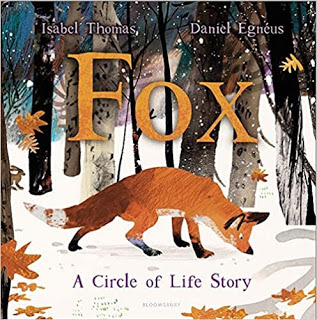
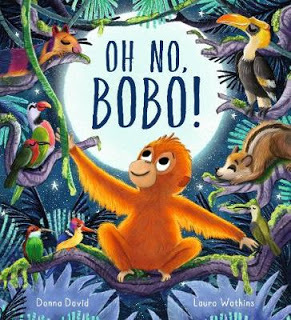
In summary, children’s books of all kinds have long contained animal characters and I can’t see that trend disappearing any time soon. Animals spark wonder in children and provide potential for beautiful, funny and engaging illustrations. But it is worth thinking carefully about the animal you choose, making sure they star in your story for all the right reasons.
BIO: Clare is the author of over 30 books for children, that star both animal and human main characters. She writes fiction and non-fiction picture book texts - sometimes funny and sometimes lyrical. She currently has books in development with Little Tiger Press, Andersen, Nosy Crow and MacMillan so watch this space. You can find out more about her at her website www.clarehelenwelsh.com or on Twitter @ClareHelenWelsh .
August 2, 2020
A Hero's Journey with Farmer Falgu
Find out more about spider diagrams here The spider diagram reveals a picture - with broken bits of web, ideas glinting through the gaps, I gather those ideas into a new image. That new image needs a structure. As much as I’m creative with ideas in the beginning, when I'm playing, when I'm daydreaming, I still need the comfort and safety of structure to organise those chaotic thoughts into a cohesive narrative. Yes! Picture Books have a structure and story arc as much as novels.
Allow me to tell you a story. The year was 2012. I had published one picture book in 2006/7 and nothing had happened since then. I had a computer full of stories – some that did see the light of day many years later. But many that will never be dusted off. I sat down to write my first Farmer Falgu story. (Yes it's a series and find out here about how it became a series).
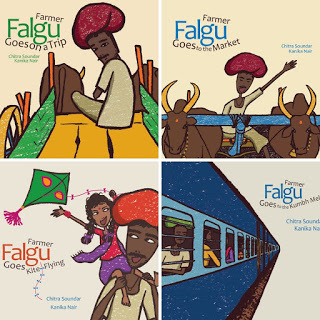 Farmer Falgu series was illustrated by Kanika Nair and published by Karadi Tales, India. Available for sale in the UK from Letterbox Library.I had a general idea of the story – it was going to be about noise and sounds. I had somehow stumbled upon the character – all I knew was that he was going to be a farmer in a farm full of animals. Perhaps it was my childhood growing up in small towns and villages, next to farms, perhaps it was reading all these English books about farms – who knows how our subconscious works and how ideas come up to the surface. Reading that story again and dissecting it during a course I taught, I realised it uses a number of structural devices. The first one - The Hero's Journey is what I'm going to talk about now.
Farmer Falgu series was illustrated by Kanika Nair and published by Karadi Tales, India. Available for sale in the UK from Letterbox Library.I had a general idea of the story – it was going to be about noise and sounds. I had somehow stumbled upon the character – all I knew was that he was going to be a farmer in a farm full of animals. Perhaps it was my childhood growing up in small towns and villages, next to farms, perhaps it was reading all these English books about farms – who knows how our subconscious works and how ideas come up to the surface. Reading that story again and dissecting it during a course I taught, I realised it uses a number of structural devices. The first one - The Hero's Journey is what I'm going to talk about now.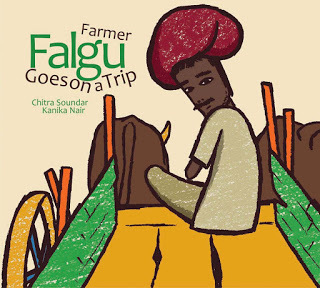
How does Farmer Falgu Goes on a Trip map to the Hero's Journey? Is Farmer Falgu going to fight evil villains and jump over aeroplanes and risk his life to save a precious treasure? Not really! At least not in this book.a) Spread 1 sets up the problem. Jumping straight in, there was no setup for who Farmer Falgu was and where he was – because that’s what the pictures will do.
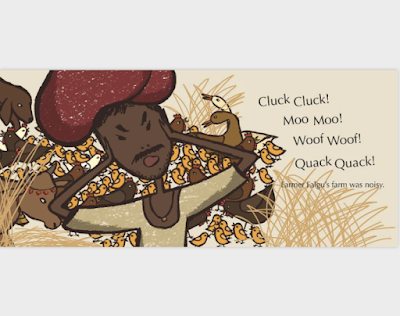
b) Spread 2 shows us the inciting incident – Farmer Falgu sets off on a trip to be away from the problem. Hence the title. c) Spread 3 – shows character – Farmer Falgu is kind and compassionate despite his troubles. But this spread also sets up a future problem.
Every action must have an equal and paying off reaction in fiction. d) Spread 4 shows the problem caused by spread 3.e) Spread 5,6 & Spread 7,8 make the problem worse. And they add to the problems.
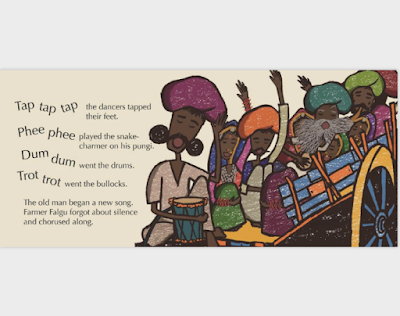
f) Spread 9 – Farmer Falgu is rid of the new problems caused by his kindness. But he hasn’t yet solved his original problem.g) Spread 10 – False hope. Farmer Falgu thinks he has achieved his goal.h) Spread 11 – Nope! He was wrong.i) Spread 12 – Farmer Falgu ponders over his original problem and he thinks about the problems over the rest of the spreads. He has a final epiphany. Yes! He has solved his problem.j) Spread 13 – He returns home with a changed mindset. Nothing in his farm has changed. But Farmer Falgu’s realisation over the course of his journey has changed his attitude.
With some exceptions of deadly battles and evil villains, this is a hero’s journey. Farmer Falgu, our hero, set off to solve a problem, confronts confounding problems, has a false sense of achievement and then loses hope and then finds the thing that makes him happy. He has gotten what he needed, not what he wanted.
To make this easy for picture book writers, I have a handy storyboard planning tool here. Based on the above dissection, here are some tips for you to take away on your own stories.
Think about your character and story as a hero’s journey. See how it maps out in terms of spreads.The planning doesn’t need to come before the writing. If you’re like me and prefer to free write, write the story, from start to finish. Make it fun and interesting and then go back and review the structure.Check the pacing with respect to the narrative. See if you have more spreads in the beginning and you’re rushing to the end.Make sure the problems are progressively complex or accumulating. In picture books, it’s a lot of fun to add to disasters culminating in a big spread of glorious hullabaloo.Check if the character has an internal need and an external want.Happy Structuring!
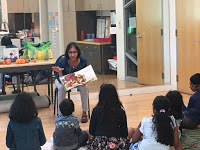 Chitra Soundar is an internationally published, award-winning author of over 40 books for children. She is also an oral storyteller with a loud voice and she also writes trade fiction, non-fiction, poetry and theatre. Her stories are inspired by folktales from India, Hindu mythology and her travels around the world. Chitra regularly runs writing workshops in schools across the world. Find out more at www.chitrasoundar.com.
Chitra Soundar is an internationally published, award-winning author of over 40 books for children. She is also an oral storyteller with a loud voice and she also writes trade fiction, non-fiction, poetry and theatre. Her stories are inspired by folktales from India, Hindu mythology and her travels around the world. Chitra regularly runs writing workshops in schools across the world. Find out more at www.chitrasoundar.com.




